- Skip to main content
Use promo code: SJT15OFF to take an extra 15% off your first purchase!
Susan Jones Teaching
Teaching Resources

How to Teach Persuasive Writing in K-2
Susan Jones January 10, 2021 2 Comments
This post may contain affiliate ads at no cost to you. See my disclosures for more information.
If you are wondering how to teach persuasive writing in kindergarten, first grade, or second grade, then this blog post is for you! I have three easy tips I am going to share with you that will help you and your students.
Before I dive in, I want to clarify two little things. First, when I teach students how to write persuasive pieces, I have already taught them how to write an opinion and provide some reasons. I like to teach students what an opinion is, how to share it, and provide reasons for it using a unit like this one: opinion writing unit , before asking them to persuade someone! Second, when teaching persuasive writing to my youngest students, I like to do this through letters. I find that when we can identify a real audience and write them a letter, students can think of better ways to persuade them. Okay, let’s dive into the three tips.
If you want to watch/listen to this content, feel free to press play on my YouTube video below where I share all the same information! While you are there, be sure to subscribe to my YouTube channel to see all my teaching videos:
To read the three tips, just keep scrolling!
Tip 1: Use Mentor Texts

These books are specifically for persuasive writing and one of my absolute favorites is Can I Be Your Dog? by Troy Cummings. In this book, a little dog named Arfy writes letters to different people to try and get them to adopt him. I particularly like this book because based on his audience, he uses different reasons to persuade. This is something we talk about in one of the later tips as well!

Another text I love to use to showcase persuasive letters is I Wanna Iguana by Karen Kaufman Orloff. This is a popular one! In this book, a little boy named Alex writes letters to his mom trying to persuade her to let him have a pet iguana. The entire book is written back and forth with letters between Alex and his mother and each letter provides reasons why he should or shouldn’t be allowed to own a pet iguana. This one is also fun because in the end, (spoiler alert) Alex ends up getting the iguana he wanted! This shows students the power of persuasion and lets the dream of something they really want and come up with ways to get it.

The last mentor text I want to share is a different one. This is one I use at the end of our unit. It is called, Olivia’s Birds: Saving the Gulf and it is written by an 11-year old girl named Oliva Bouler. When I teach persuasive writing in a K-2 classroom, our letters tend to be pretty self-serving. This isn’t a bad thing at all! In fact, that’s why writing the letters can be so much fun – to try and get what we want. This text, however, lets students see how powerful our words can be and how we can try to persuade people to make the world a better place.
In Olivia’s Birds , the author shares all sorts of interesting facts about different birds with her illustrations and how some human acts are destroying the birds’ habitats. In the end, she writes a persuasive letter to the Audubon Society and ends up single-handedly raising over $150,000 to help her cause! I love this book because it is inspiring and gets students thinking of ways they can change the world with their voices!

Please note: all books shown above are Amazon affiliate links
After we read Olivia’s Birds, we can use her ideas as an extension to write our own class book. Here are some of the ideas we use to brainstorm our own class persuasive letter:

Tip 2: Have your students Identify Persuasion in a Mentor Text
When using mentor texts, not only do I like to have students see persuasive writing in action, but I like to have them identify the persuasion in the texts. We do this using a think-aloud sheet like shown below.

As we read one of the mentor texts, we identify what the character wants, who the audience is, and then some of the reasons the character uses to persuade their audience. When doing this, I model this think-aloud with the class first and I use some student input as we gather reasons to persuade. I like having students walk through this process before we actually write our letters because it gets them used to brainstorming what they want, their audience, and some reasons to persuade. I also like this sheet because we can use it over and over again with different mentor texts!
You can grab this think-aloud sheet FREE here >> Persuasive Writing Activity and try it out in your own classroom!
Tip 3: Connect Reasons to their Audience
Unlike when we write opinions and share our reasons for them, persuasive writing has us making our reasons more personal. If we are trying to persuade someone, we need to think more in-depth about our audience! When doing this, I love to use a think-aloud and the mentor text, Can I Be Your Dog? which was shown above. Using a chart like shown below, we think about the different reasons Arfy uses to persuade his different audiences.

As we re-read the mentor text, we talk about how Arfy uses different reasons to persuade the people in the yellow house than the reasons he uses to persuade the fire station. This gets students not just thinking about what THEY want, but also how THEIR AUDIENCE could be persuaded!
I re-emphasize this as I model planning out my own persuasive letter to my principal! I like to use a fun example. I explain that when I speak to my son, I might use “baby voice” but I wouldn’t use that same baby voice with my boss! We need to speak differently and think of reasons that connect with each of our own audiences in order to effectively persuade them.
Those are the 3 tips I have to help you teach your students write persuasive letters! If you have other mentor texts or ideas that you love using with your kindergarten, first grade, or second-grade students, please drop them in the comments!
If you want to see more videos with ideas for teaching writing in a K-2 classroom, just click my writing workshop playlist below:
Pin to remember:

You may also enjoy these posts...

Reader Interactions
July 18, 2021 at 2:54 pm
Very useful lessons of writing Thank you
October 1, 2021 at 9:06 pm
I just finished watching your first writing video and found it very educational. I have recently started to homeschool my fourth-grade son. I am noticing he finds it very difficult to think of information to write when he is writing from a prompt or a book. I am thinking about starting at a lower level of writing perhaps maybe first grade or kindergarten in order to build his writing confidence. I am open to any suggestions, please.
Leave a Comment Cancel reply
Your email address will not be published. Required fields are marked *
This site uses Akismet to reduce spam. Learn how your comment data is processed .

Free CVC Word Mapping Mats
Sign up for my free email newsletter and receive these free CVC Word Mapping Mats to help with your next lesson plan!
Check out these popular writing resources!
We have loads of great writing resources over in the shop. Here are just a few I pulled together for you!

Beginning of the Year Writing

First Grade Writer’s Workshop units

Paragraph Writing Activities & Lessons: PRINTABLE & DIGITAL (Seesaw & Google)

Opinion Writing Unit
Hello friends.
Welcome to Susan Jones Teaching. When it comes to the primary grades, learning *All Things* in the K-2 world has been my passion for many years! I just finished my M.Ed. in Curriculum and Instruction and love sharing all the latest and greatest strategies I learn with you through this blog and my YouTube channel! I hope you'll enjoy learning along with me :)
More About Me


How to Write Perfect Persuasive Essays in 5 Simple Steps
WHAT IS A PERSUASIVE ESSAY?

A persuasive text presents a point of view around a topic or theme that is backed by evidence to support it.
The purpose of a persuasive text can be varied. Maybe you intend to influence someone’s opinion on a specific topic, or you might aim to sell a product or service through an advertisement.
The challenge in writing a good persuasive text is to use a mix of emotive language and, in some cases, images that are supported by hard evidence or other people’s opinions.
In a persuasive essay or argument essay, the student strives to convince the reader of the merits of their opinion or stance on a particular issue. The student must utilise several persuasive techniques to form a coherent and logical argument to convince the reader of a point of view or to take a specific action.

PERSUADING PEOPLE REQUIRES A CONSISTENT APPROACH…
Persuasive texts are simple in structure. You must clearly state your opinion around a specific topic and then repeatedly reinforce your opinions with external facts or evidence. A robust concluding summary should leave little doubt in the reader’s mind. ( Please view our planning tool below for a detailed explanation. )
TYPES OF PERSUASIVE TEXT
We cover the broad topic of writing a general persuasive essay in this guide, there are several sub-genres of persuasive texts students will encounter as they progress through school. We have complete guides on these text types, so be sure to click the links and read these in detail if required.
- Argumentative Essays – These are your structured “Dogs are better pets than Cats” opinion-type essays where your role is to upsell the positive elements of your opinions to your audience whilst also highlighting the negative aspects of any opposing views using a range of persuasive language and techniques.
- Advertising – Uses persuasive techniques to sell a good or service to potential customers with a call to action.
- Debating Speeches – A debate is a structured discussion between two teams on a specific topic that a moderator judges and scores. Your role is to state your case, sell your opinions to the audience, and counteract your opposition’s opinions.
- Opinion Articles, Newspaper Editorials. – Editorials often use more subtle persuasive techniques that blur the lines of factual news reporting and opinions that tell a story with bias. Sometimes they may even have a call to action at the end.
- Reviews – Reviews exist to inform others about almost any service or product, such as a film, restaurant, or product. Depending on your experiences, you may have firm opinions or not even care that much about recommending it to others. Either way, you will employ various persuasive techniques to communicate your recommendations to your audience.
- Please note a DISCUSSION essay is not a traditional persuasive text, as even though you are comparing and contrasting elements, the role of the author is to present an unbiased account of both sides so that the reader can make a decision that works best for them. Discussions are often confused as a form of persuasive writing.
A COMPLETE TEACHING UNIT ON PERSUASIVE WRITING SKILLS

Teach your students to produce writing that PERSUADES and INFLUENCES thinking with this HUGE writing guide bundle covering: ⭐ Persuasive Texts / Essays ⭐ Expository Essays⭐ Argumentative Essays⭐ Discussions.
A complete 140 PAGE unit of work on persuasive texts for teachers and students. No preparation is required.
THE STRUCTURE OF A PERSUASIVE ESSAY

1. Introduction
In the introduction, the student will naturally introduce the topic. Controversial issues make for great topics in this writing genre. It’s a cliche in polite society to discourage discussions involving politics, sex, or religion because they can often be very divisive. While these subjects may not be the best topics of conversation for the dinner table at Thanksgiving, they can be perfect when deciding on a topic for persuasive writing. Obviously, the student’s age and abilities should be considered, as well as cultural taboos, when selecting a topic for the essay. But the point holds, the more controversial, the better.
Let’s take a look at some of the critical elements of the introduction when writing a persuasive essay:
Title: Tell your audience what they are reading.
This will often be posed as a question; for example, if the essay is on the merits of a vegetarian lifestyle, it may be called something like: To Eat Meat or Not?
Hook : Provide your audience with a reason to continue reading.
As with any genre of writing, capturing the reader’s interest from the outset is crucial. There are several methods of doing this, known as hooks. Students may open their essays with anecdotes, jokes, quotations, or relevant statistics related to the topic under discussion.
Background: Provide some context to your audience.
In this introductory section, students will provide the reader with some background on the topic. This will place the issue in context and briefly weigh some opinions on the subject.
Thesis statement: Let the audience know your stance.
After surveying the topic in the first part of the introduction, it is now time for the student writer to express their opinion and briefly preview the points they will make later in the essay.
2. Body Paragraphs
The number of paragraphs forming this essay section will depend on the number of points the writer chooses to make to support their opinion. Usually three main points will be sufficient for beginning writers to coordinate. More advanced students can increase the number of paragraphs based on the complexity of their arguments, but the overall structure will largely remain intact.
Be sure to check out our complete guide to writing perfect paragraphs here .
The TEEL acronym is valuable for students to remember how to structure their paragraphs. Read below for a deeper understanding.
Topic Sentence:
The topic sentence states the central point of the paragraph. This will be one of the reasons supporting the thesis statement made in the introduction.
These sentences will build on the topic sentence by illustrating the point further, often by making it more specific.
These sentences’ purpose is to support the paragraph’s central point by providing supporting evidence and examples. This evidence may be statistics, quotations, or anecdotal evidence.
The final part of the paragraph links back to the initial statement of the topic sentence while also forming a bridge to the next point to be made. This part of the paragraph provides some personal analysis and interpretation of how the student arrived at their conclusions and connects the essay as a cohesive whole.
3. Conclusion
The conclusion weaves together the main points of the persuasive essay. It does not usually introduce new arguments or evidence but instead reviews the arguments made already and restates them by summing them up uniquely. It is important at this stage to tie everything back to the initial thesis statement. This is the writer’s last opportunity to drive home their point, to achieve the essay’s goal, to begin with – persuade the reader of their point of view.

Ending an essay well can be challenging, but it is essential to end strongly, especially for persuasive essays. As with the hooks of the essay’s opening, there are many tried and tested methods of leaving the reader with a strong impression. Encourage students to experiment with different endings, for example, concluding the essay with a quotation that amplifies the thesis statement.
Another method is to have the student rework their ending in simple monosyllabic words, as simple language often has the effect of being more decisive in impact. The effect they are striving for in the final sentence is the closing of the circle.
Several persuasive writing techniques can be used in the conclusion and throughout the essay to amp up the persuasive power of the writing. Let’s take a look at a few.
ETHOS, PATHOS & LOGOS TUTORIAL VIDEO (2:20)

TIPS FOR WRITING A GREAT PERSUASIVE ESSAY

PERSUASIVE TECHNIQUES
In this article, we have outlined a basic structure that will be helpful to students in approaching the organization of their persuasive writing. It will also be helpful for the students to be introduced to a few literary techniques that will help your students to present their ideas convincingly. Here are a few of the more common ones:
Repetition: There is a reason why advertisements and commercials are so repetitive – repetition works! Students can use this knowledge to their advantage in their persuasive writing. It is challenging to get the reader to fully agree with the writer’s opinion if they don’t fully understand it. Saying the same thing in various ways ensures the reader gets many bites at the ‘understanding’ cherry.
Repetition Example: “The use of plastic bags is not only bad for the environment, but it is also bad for our economy. Plastic bags are not biodegradable, meaning they will not decompose and will continue to take up space in landfills. Plastic bags are also not recyclable, meaning they will not be reused and will instead end up in landfills. Plastic bags are not only bad for the environment, but they are also bad for our economy as they are costly to dispose of and take up valuable space in landfills.”
In this example, the phrase “not only bad for the environment but also bad for our economy” is repeated multiple times to reinforce the idea that plastic bags are not just a problem for the environment but also the economy. The repetition of the phrase emphasizes the point and makes it more persuasive.
It is also important to note that repetition could be used differently, such as repeating a word or phrase to create rhythm or emphasis.
Storytelling: Humans tend to understand things better through stories. Think of how we teach kids important values through time-tested fables like Peter and the Wolf . Whether through personal anecdotes or references to third-person experiences, stories help climb down the ladder of abstraction and reach the reader on a human level.
Storytelling Example: “Imagine you are walking down the street, and you come across a stray dog clearly in need of food and water. The dog looks up at you with big, sad eyes, and you cannot help but feel a twinge of compassion. Now, imagine that same scenario, but instead of a stray dog, it’s a homeless person sitting on the sidewalk. The person is clearly in need of food and shelter, and their eyes also look up at her with a sense of hopelessness.
The point of this story is to show that just as we feel compelled to help a stray animal in need, we should also feel compelled to help a homeless person. We should not turn a blind eye to the suffering of our fellow human beings, and we should take action to address homelessness in our community. It is important to remember that everyone deserves a roof over their head and a warm meal to eat. The story is designed to elicit an emotional response in the reader and make the argument more relatable and impactful.
By using storytelling, this passage creates an image in the reader’s mind and creates an emotional connection that can be more persuasive than just stating facts and figures.

Dissent: We live in a cynical age, so leaving out the opposing opinion will smack of avoidance to the reader. Encourage your students to turn to that opposing viewpoint and deal with those arguments in their essays .
Dissent Example: “Many people argue that students should not have to wear uniforms in school. They argue that uniforms stifle creativity and individuality and that students should be able to express themselves through their clothing choices. While these are valid concerns, I strongly disagree.
In fact, uniforms can actually promote individuality by levelling the playing field and removing the pressure to dress in a certain way. Furthermore, uniforms can promote a sense of community and belonging within a school. They can also provide a sense of discipline and structure, which can help to create a more focused and productive learning environment. Additionally, uniforms can save families money and eliminate the stress of deciding what to wear daily .
While some may argue that uniforms stifle creativity and individuality, the benefits of uniforms far outweigh the potential drawbacks. It is important to consider the impact of uniforms on the school as a whole, rather than focusing solely on individual expression.”
In this example, the writer presents the opposing viewpoint (uniforms stifle creativity and individuality) and then provides counterarguments to refute it. By doing so, the writer can strengthen their own argument and present a more convincing case for why uniforms should be worn in school.
A Call to Action: A staple of advertising, a call to action can also be used in persuasive writing. When employed, it usually forms part of the conclusion section of the essay and asks the reader to do something, such as recycle, donate to charity, sign a petition etc.
A quick look around reveals to us the power of persuasion, whether in product advertisements, newspaper editorials, or political electioneering; persuasion is an ever-present element in our daily lives. Logic and reason are essential in persuasion, but they are not the only techniques. The dark arts of persuasion can prey on emotion, greed, and bias. Learning to write persuasively can help our students recognize well-made arguments and help to inoculate them against the more sinister manifestations of persuasion.
Call to Action Example: “Climate change is a pressing issue that affects us all, and it’s important that we take action now to reduce our carbon footprint and protect the planet for future generations. As a society, we have the power to make a difference and it starts with small changes that we can make in our own lives.
I urge you to take the following steps to reduce your carbon footprint:
- Reduce your use of single-use plastics
- Use public transportation, carpool, bike or walk instead of driving alone.
- Support clean energy sources such as solar and wind power
- Plant trees and support conservation efforts
It’s easy to feel like one person can’t make a difference, but the truth is that every little bit helps. Together, we can create a more sustainable future for ourselves and for the planet.
So, let’s take action today and make a difference for a better future, it starts with minor changes, but it all adds up and can make a significant impact. We need to take responsibility for our actions and do our part to protect the planet.”
In this example, the writer gives a clear and specific call to action and encourages the reader to take action to reduce their carbon footprint and protect the planet. By doing this, the writer empowers the reader to take action and enables them to change.
Now, go persuade your students of the importance of perfecting the art of persuasive writing!
A COMPLETE UNIT ON TEACHING FACT AND OPINION

This HUGE 120 PAGE resource combines four different fact and opinion activities you can undertake as a WHOLE GROUP or as INDEPENDENT READING GROUP TASKS in either DIGITAL or PRINTABLE TASKS.
20 POPULAR PERSUASIVE ESSAY TOPICS FOR STUDENTS
Writing an effective persuasive essay demonstrates a range of skills that will be of great use in nearly all aspects of life after school.

In essence, if you can influence a person to change their ideas or thoughts on a given topic through how you structure your words and thoughts, you possess a very powerful skill.
Be careful not to rant wildly. Use facts and other people’s ideas who think similarly to you in your essay to strengthen your concepts.
Your biggest challenge in getting started may be choosing a suitable persuasive essay topic. These 20 topics for a persuasive essay should make this process a little easier.
- WHY ARE WE FASCINATED WITH CELEBRITIES AND WEALTHY PEOPLE ON TELEVISION AND SOCIAL MEDIA?
- IS IT RIGHT FOR SCHOOLS TO RAISE MONEY BY SELLING CANDY AND UNHEALTHY FOODS TO STUDENTS?
- SHOULD GIRLS BE ALLOWED TO PLAY ON BOYS SPORTING TEAMS?
- IS TEACHING HANDWRITING A WASTE OF TIME IN THIS DAY AND AGE?
- SHOULD THERE BE FAR GREATER RESTRICTIONS AROUND WHAT CAN BE POSTED ON THE INTERNET?
- SHOULD PROFESSIONAL ATHLETES HAVE TO TAKE DRUG TESTS?
- ARE TEENAGE PREGNANCY SHOWS A NEGATIVE OR POSITIVE INFLUENCE ON VIEWERS?
- SHOULD GAMBLING BE PROMOTED IN ANY WAY IN SPORTS EVEN THOUGH IT BRINGS IN LARGE AMOUNTS OF REVENUE?
- SHOULD SPORTING TEAMS THAT LOSE BE REWARDED BY RECEIVING INCENTIVES SUCH AS HIGH DRAFT PICKS AND / OR FINANCIAL BENEFITS?
- SHOULD SHARKS THAT ATTACK PEOPLE BE DESTROYED? SHOULD WE GET INVOLVED IN FOREIGN CONFLICTS AND ISSUES THAT DON’T DIRECTLY AFFECT OUR COUNTRY?
- SHOULD WE GET INVOLVED IN FOREIGN CONFLICTS AND ISSUES THAT DON’T DIRECTLY AFFECT OUR COUNTRY?
- COULD VIDEO GAMES BE CONSIDERED AS A PROFESSIONAL SPORT?
- IF YOU WERE THE LEADER OF YOUR COUNTRY AND HAD A LARGE SURPLUS TO SPEND, WHAT WOULD YOU DO WITH IT?
- WHEN SHOULD A PERSON BE CONSIDERED AND TREATED AS AN ADULT?
- SHOULD SMOKING BECOME AN ILLEGAL ACTIVITY?
- SHOULD THE VOTING AGE BE LOWERED?
- DOES PROTECTIVE PADDING IN SPORTS MAKE IT MORE DANGEROUS?
- SHOULD CELL PHONES BE ALLOWED IN THE CLASSROOM?
- IS TEACHING A FOREIGN LANGUAGE A WASTE OF TIME?
- SHOULD WE TEACH ETIQUETTE IN SCHOOLS?
PERSUASIVE PROMPTS FOR RELUCTANT WRITERS
If your students need a little more direction and guidance, here are some journal prompts that include aspects to consider.
- Convince us that students would be better off having a three-day weekend . There are many angles you could take with this, such as letting children maximize their childhood or trying to convince your audience that a four-day school week might actually be more productive.
- Which is the best season? And why? You will really need to draw on the benefits of your preferred season and sell them to your audience. Where possible, highlight the negatives of the competing seasons. Use lots of figurative language and sensory and emotional connections for this topic.
- Aliens do / or don’t exist? We can see millions of stars surrounding us just by gazing into the night sky, suggesting alien life should exist, right? Many would argue that if there were aliens we would have seen tangible evidence of them by now. The only fact is that we just don’t know the answer to this question. It is your task to try and convince your audience through some research and logic what your point of view is and why.
- Should school uniforms be mandatory? Do your research on this popular and divisive topic and make your position clear on where you stand and why. Use plenty of real-world examples to support your thoughts and points of view.
- Should Smartphones be banned in schools? Whilst this would be a complete nightmare for most students’ social lives, maybe it might make schools more productive places for students to focus and learn. Pick a position, have at least three solid arguments to support your point of view, and sell them to your audience.
VISUAL JOURNAL PROMPTS FOR PERSUASIVE WRITING
Try these engaging, persuasive prompts with your students to ignite the writing process . Scroll through them.

Persuasive Essay Examples (Student Writing Samples)
Below are a collection of persuasive essay samples. Click on the image to enlarge and explore them in greater detail. Please take a moment to read the persuasive texts in detail and the teacher and student guides highlight some of the critical elements of writing a persuasion.
Please understand these student writing samples are not intended to be perfect examples for each age or grade level but a piece of writing for students and teachers to explore together to critically analyze to improve student writing skills and deepen their understanding of persuasive text writing.
We recommend reading the example either a year above or below, as well as the grade you are currently working with, to gain a broader appreciation of this text type.

VIDEO TUTORIALS FOR PERSUASIVE WRITING

OTHER GREAT ARTICLES RELATED TO PERSUASIVE ESSAY WRITING

Teaching Resources
Use our resources and tools to improve your student’s writing skills through proven teaching strategies.
WHERE CAN I FIND A COMPLETE UNIT OF WORK ON HOW TO WRITE PERSUASIVE ESSAYS?

We pride ourselves on being the web’s best resource for teaching students and teachers how to write a persuasive text. We value the fact you have taken the time to read our comprehensive guides to understand the fundamentals of writing skills.
We also understand some of you just don’t have the luxury of time or the resources to create engaging resources exactly when you need them.
If you are time-poor and looking for an in-depth solution that encompasses all of the concepts outlined in this article, I strongly recommend looking at the “ Writing to Persuade and Influence Unit. ”
Working in partnership with Innovative Teaching Ideas , we confidently recommend this resource as an all-in-one solution to teach how to write persuasively.
This unit will find over 140 pages of engaging and innovative teaching ideas.
PERSUASIVE ESSAY WRITING CHECKLIST AND RUBRIC BUNDLE

The Ultimate Guide to Opinion Writing for Students and Teachers

Top 5 Persuasive Writing Techniques for Students

5 Top Persuasive Writing Lesson Plans for Students and Teachers

23 Persuasive writing Topics for High School students

How to Write an Advertisement: A Complete Guide for Students and Teachers

How to Start an Essay with Strong Hooks and Leads
MAKE WAVES WITH THIS FREE WEEKLONG VOCABULARY UNIT!

10 Steps to Teach Persuasive Writing
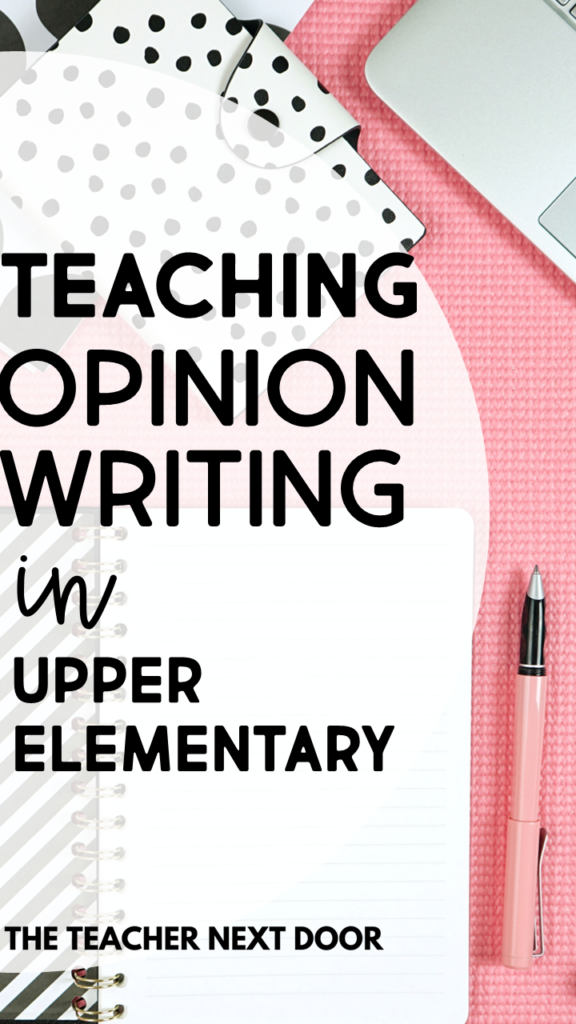
Kids are natural-born persuaders. They do it all the time. The trick as a teacher is to take their set of skills and help them use their power for good. And by good, I mean to channel these skills into writing effective persuasive pieces.
So, what exactly do we need to do to teach persuasive writing? I won’t lie to you…it’s not an easy task, but I’ll try to break it down here and simplify the steps to hopefully make this something that you can use in your classroom.
1. Teach Paragraph Writing FIRST
Before I even begin to think about teaching students to create an opinion piece, I make sure that my class has learned the basics of writing a good paragraph. We spend a lot of time with each component, and after they’ve mastered one paragraph, we move on to the five-paragraph essay.
Since I teach 4th/5th, this is one of the standards we need to reach. Once I know that students can write a reasonably good essay, then they can learn an opinion essay a little more easily.
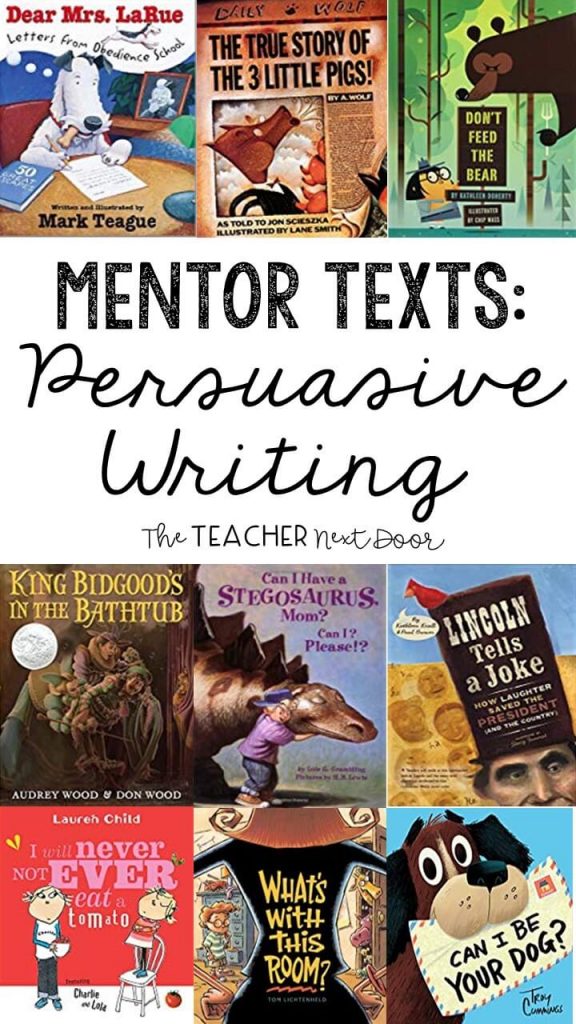
2. Use Mentor Texts to Introduce Opinion Writing
I am a big fan of mentor texts. I just love how picture books easily capture the attention of my “big” kids, while quickly teaching them so many lessons.
When I teach opinion writing, I like to gather several of these persuasive mentor texts and share them with my class. We talk about how the character used persuasive techniques well, or how he/she didn’t.
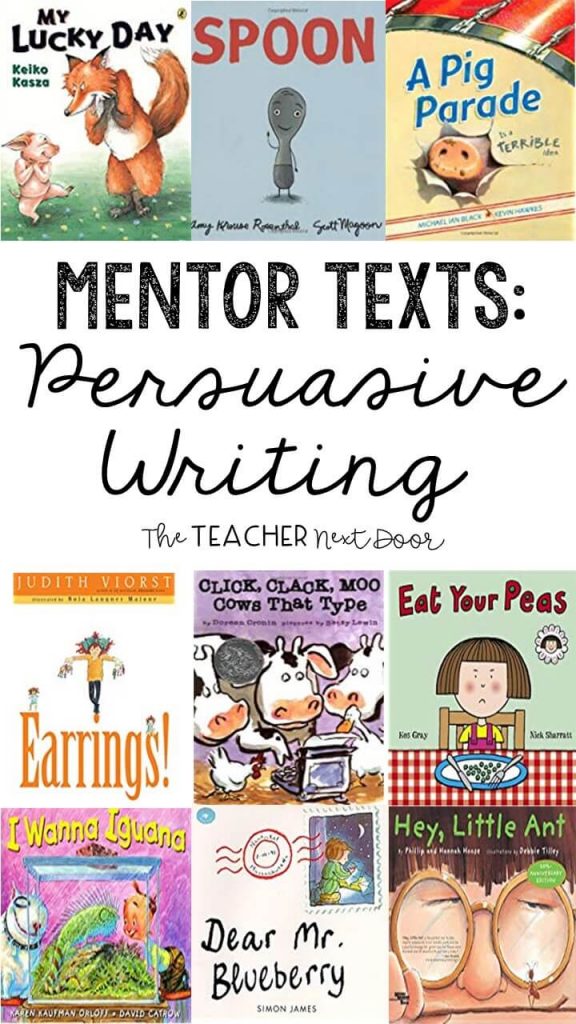
3. Start With the Big Picture
Before we start to officially write, we talk about what an opinion essay is and isn’t. I like to give students three choices with similar topics and ask them which one is the opinion essay. For example, they might choose between these titles: The Magical Elephant, Elephants and Their Families, and How to Save the Elephants. Next, I have a handout that shows the structure of an opinion essay. Since we’ve written five-paragraph essays before, they have a good handle on the basic essay structure. Then I guide them step by step through each component. We absolutely do not write a single opinion essay until we’ve had the opportunity to have lots of mini-lessons, see many examples, and practice all parts of the essay in a very low-stakes environment.
4. The Introduction Paragraph is First
A. introduce hooks.
Now we spend some time focusing on how to start the essay. We start by using a hook (also called a lead).
I like to describe a writing “hook” using a fishing analogy. The fisherman puts a nice pink, juicy worm on the hook, hoping to attract the attention of the fish. If the fish bites, the fisherman’s happy. If the fish doesn’t bite, that means that it wasn’t interested in the hook, and there won’t be any fish caught.
Our goal as a writer is to get the reader interested by “hooking” them into reading our essay, from the very first sentence.
We go over six different types of hooks and practice these. I also love using opinion writing posters as I introduce each new opinion essay concept. They’re a great reference for students on the wall or printed in miniature for writing notebooks.
B. Review Topic Sentences
For an opinion essay, the topic sentence is the opinion sentence. It is the author’s viewpoint. We do a lesson reviewing the five types of topic sentences we use for paragraph and essay writing, and I show students how to tweak these into opinion statements.
C. Time to Add the Three Reasons
The last part of the introduction lists the three reasons for our opinion. I teach students that these can be listed as a single sentence with commas between them, or we can write three separate sentences, one for each reason.
For the first lesson on reasons, I give students a topic (cell phones or vending machines at school or which season is the best, etc.) and then ask students to write three bullet points on their whiteboards. Next to each one, they write a word to describe a reason they like/dislike this idea.
For example, if the topic was school uniforms, the child might write lack of individuality, gets boring, uncomfortable… I can quickly glance at their lists while we discuss a few of them, and then we’re ready to practice with the next topic.
Without writing a whole essay, this is teaching students to think about organization and how reasons help support their opinions. I think this kind of practice is great!
When we transition this activity to a full essay, these reasons would turn into the topic sentences for each body paragraph of a five-paragraph opinion essay!
Btw.. if you don’t have whiteboards for your class, this is something you’ll really want to consider. They’re great for writing practice and so many things. I actually purchased shower boards at Home Depot for about $15 to make into whiteboards. They cut them into 12 x 12-inch squares for me for free!
5. Review, Review, Review
After we spend some time on each main section of the opinion essay (the introduction, the body paragraphs, and the conclusion), I like to give my students activities to really reinforce what they’ve learned. Besides review worksheets, we do games (like Stump the Expert), sorts, and color coding.
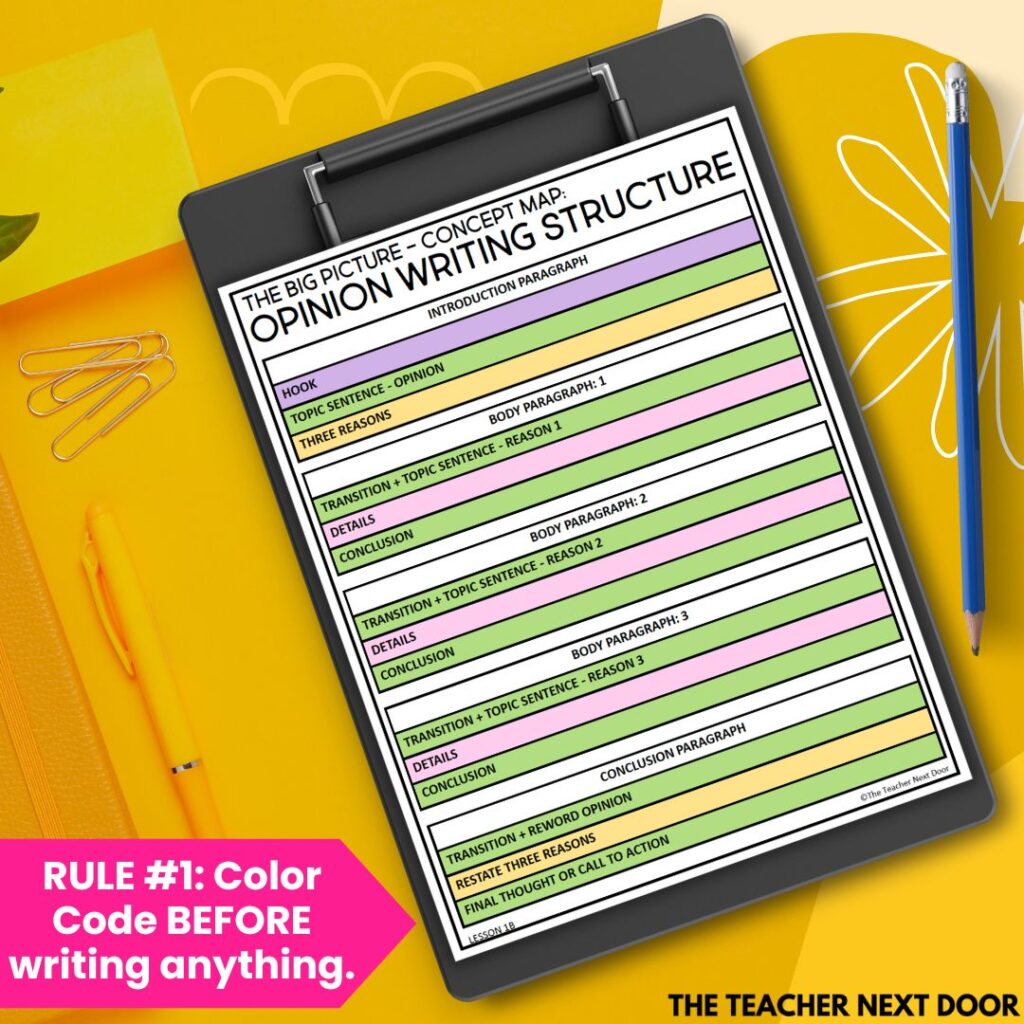
I really like to have students color code already-made paragraphs so they can see examples of quality writing, and they can master the structure of the paragraph . Once we’ve reviewed the introduction, it’s time to move on to the body paragraphs.
6. The Three Body Paragraphs are Next
There are three parts of each body paragraph, and I teach each part separately, one by one. The parts include a topic sentence that starts with a transition, three to five details to describe and explain the author’s reason for his/her viewpoint, and a conclusion sentence.
These three paragraphs are the meat of the essay. This is where students explain why they support or don’t support something.
We spend time doing activities like looking at three sentences and identifying which one is the topic sentence, which one is a detail, and which one is a conclusion sentence.
We look at pre-made topic sentences and related conclusion sentences and rate them as part of a great class discussion and then in pairs or independently. Then, we review with more color coding, games, and sorts.
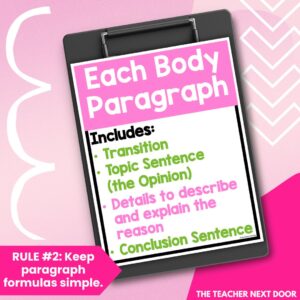
7. Focus on the Conclusion Paragraph
Conclusions can be a little intimidating for some students. Maybe it’s because they’re tired from the heavy lifting of the other four paragraphs, but with practice, you can help take away some of their apprehension and replace it with confidence!
The conclusion paragraph is a shorter paragraph (in 3rd – 5th grade) than a body paragraph. It has three distinct parts, an opinion sentence that starts with a transition, the three reasons, and a final thought or call to action.
A. The Opinion Sentence Starting with a Transition
The opinion sentence is really a topic sentence. It reinforces the same idea presented in the introduction paragraph but uses synonyms and usually a different type of topic sentence than the introduction to add variety.
We go over specific transitions that can be used for conclusions. While students may not always use a transition for their conclusion later on, I think it gives students structure and helps them break the ice of crafting a strong conclusion paragraph.
B. The Three Reasons (again!)
Just like the introduction paragraph, the conclusion paragraph lists the three reasons, usually in a single sentence with commas. Like always, you’ll want students to reword the sentence using synonyms to add variety.
C. The Conclusion, The Ending, The VERY LAST SENTENCE!
This last sentence is another place students may feel apprehensive to write at first. We go over the difference between a final thought and a call to action and practice by seeing lots of exemplars and then creating our own.
By the time we’re finished, most students understand how to gracefully and effectively add the conclusion sentence to finish the opinion essay.
Just like we usually do, once we finish a section, we review that section carefully using handouts, sorts, color coding, games, and reviews.
8. Share an Opinion Essay Example
It’s one thing to talk about an opinion essay’s components and to even practice them. It’s another thing to see a really good example of an essay and to get to go through it and discuss what makes it work and why.
I have several great examples I’ve saved over the years (and I have two that I wrote and included in my opinion essay unit). We take time to color code the essay and then create a reverse outline for it. They save this essay as an example.
9. Make an Outline and an Essay as a Whole Class (Eeek!)
Okay, here’s where your perseverance has to kick in.
Trying to complete an essay as a whole class will drive even the most saintly of teachers to want to pull their hair out at times, but this hard part is crucial. There, I said it. It is that important that this is a step you shouldn’t miss.
Here’s how I do it. I break it down into two to four days. On the first day, we created an outline together. I have students write this outline in their Writer’s Notebooks as a model to refer to when they need to make their own outline later.
We always do school uniforms, because I find it to be a great topic and one that my students feel strongly about.
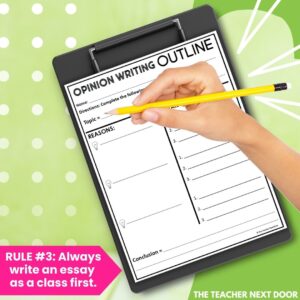
I tell them for the sake of continuity, we need to take a stand as a class for the essay, whether they really agree with that stand or not. We take a class vote and then stick with it, whether it’s for or against the uniform idea.
On the second day, when we have the outline in place, I make a deal with the kids…I tell them if they stick with me, stay on task, and participate…I’ll do the writing (this time), and they can just tell me what to write.
If they don’t stay focused, then they’ll have to write it themselves. This works like magic. I’ve never had a class that lost out on this “deal.”
So, using yesterday’s outline, we go step by step and write each paragraph together. Students feed me sentences (I write these on the SmartBoard), which I try to use or gently guide them a bit where needed.
Usually, we do about 2 paragraphs in one day. The attention spans of 8 – 11-year-olds can be a killer, so I find that breaking it into several days helps.
10. Before Students Write – Go over Expectations Using a Rubric
I really like to use rubrics for lots of assignments. It breaks down the activity into its components, and it also serves as a road map for students to know what is expected of them. I think the more we can explain to students exactly what we’re looking for, the more they can meet and sometimes exceed (hallelujah) our expectations.
There’s never a reason to hide what we want from students, in my opinion. So, we go over the rubric together, and it’s a kind of review for all the lessons leading up to this. You can three-hole punch it so they can store it in their binders, or you can print it in a smaller size to fit their Writer’s Notebooks if you wish.
BONUS #11. Practice Writing Opinion Essays…Over and Over and…
Once your students have practiced each part of the opinion essay and are very familiar with its structure, it’s their turn to write independently. I choose several different topics for them over the next few weeks, and we do about an essay a week in class. The students get better as time goes by, and usually, I let them choose a topic for the last essay or two. It’s interesting to see what they come up with.
Whew…such a huge unit and so many skills to fit in, but in my mind, it is an awesome unit. I love teaching it because of the great number of discussions it provides and because I see it as an important set of tools for them to have in their writing toolboxes.

If you’d like some resources for opinion writing , I love this unit I created. It’s a bundle with over 100 printable pages and includes a digital format too. It will take you through the entire process with teaching pages, and detailed teaching notes, student practice pages, activities, and posters for 3rd – 5th grade.
Sarah is a 4th Grade Teacher and uses this unit and process in her classroom. This is what she had to say.

CLICK HERE TO FIND THE OPINION WRITING BUNDLE ON TPT!

- Read more about: Writing & Grammar
You might also like...

Unlocking Student Writing Success: The Power of Explicit Writing Instruction
As upper elementary teachers, our goal is to create strong writers. However, the lack of Explicit Writing Instruction has caused students in the US to
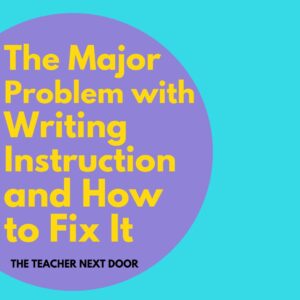
The Major Problem with Writing Instruction and How to Fix It
Writing instruction at the elementary level needs an overhaul. The last time the National Assessment of Education Progress (NAEP) measured 8th-grade students’ writing proficiency in
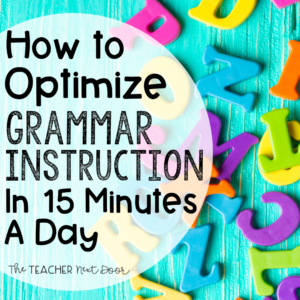
How to Optimize Grammar Instruction in 15 Minutes a Day
As elementary school teachers, we are always thinking about how to integrate subjects. History content and nonfiction text features. A science equation and a math
Hi, I’m Jenn, CEO and owner of The Teacher Next Door!
I know that you strive to be an effective upper elementary teacher while maintaining a healthy work-life balance.
In order to do that, you need resources that are impactful, yet simple .
The problem is that most resources and curriculums out there are far from simple. The pages upon pages of daily lesson plans are just plain overwhelming .
At TTND, we believe teachers should be living their lives outside of the classroom, and not spend hours lesson planning and searching for resources.
We understand that now, more than ever, teachers need space to be themselves which is why we create and support teachers with timesaving tips and standards-aligned resources.
Want access to TTND's Free Resource Library? Sign up for our newsletter and we'll email you the exclusive password!
Trending posts.

SEARCH BY TOPIC
- Classroom Ideas
- Holidays and Seasonal
- Mentor Texts
- Reading Block
- Uncategorized
- Writing & Grammar
POPULAR RESOURCES

Facebook Group
Teachers Pay Teachers
Free Resource Library
💌 Contact Us
Disclosures
Privacy Policy
Refund Policy
Purchase Orders
Your Downloads
Reward Points
© The Teacher Next Door, LLC. All rights reserved.
Best Back to School Ideas 🍏
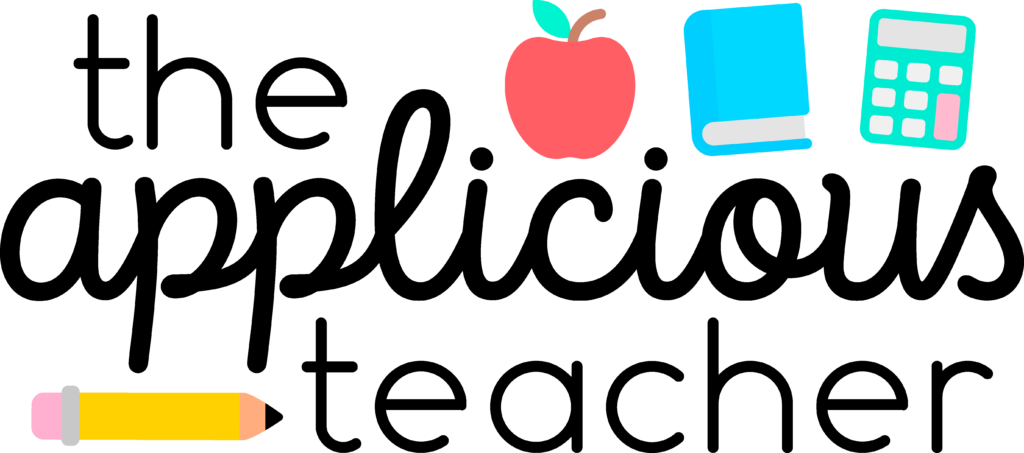
Snack Attack Persuasive Writing Activity for 2nd Grade
Share this post:.
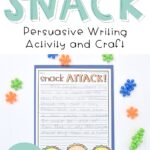
Teaching persuasive writing to your kiddos can seem tricky at first. You might find yourself wondering where to start or trying to decide what resources to use. But, don’t worry, because I have the perfect activity that your 2nd graders will love! This Snack Attack Writing activity is the answer you have been looking for. Come check out this awesome resource!
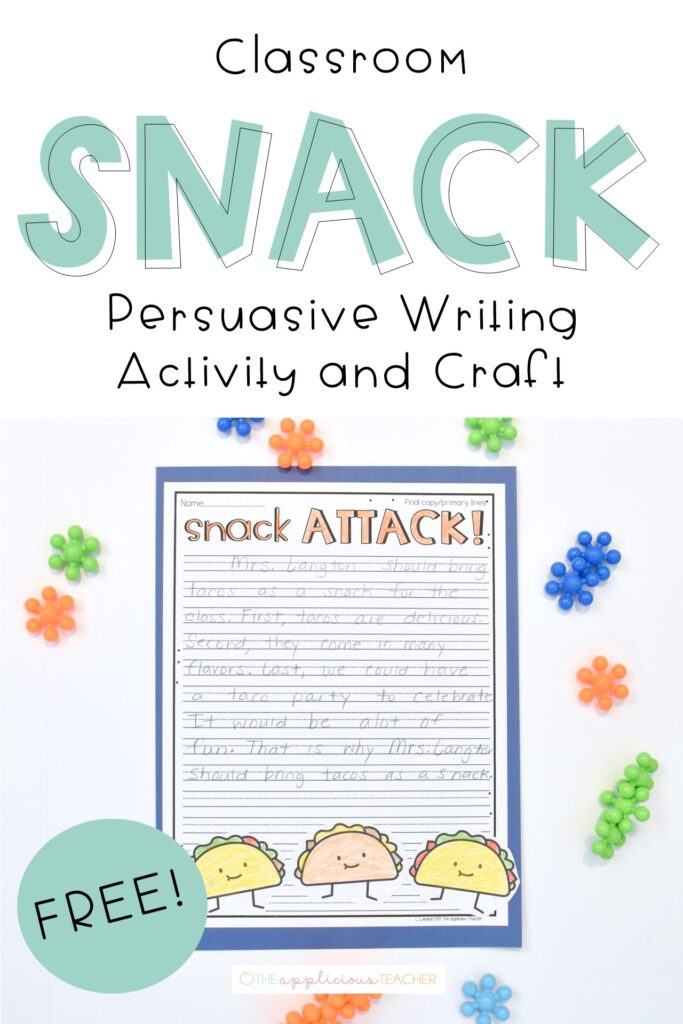
Please note this post contains affiliate links. Please know that I make a very small commission from your purchase if you follow my links. There is no cost to you, but this extra coinage allows me to continue creating free resources and writing awesome content for you!
Snack Attack Persuasive Writing Activity
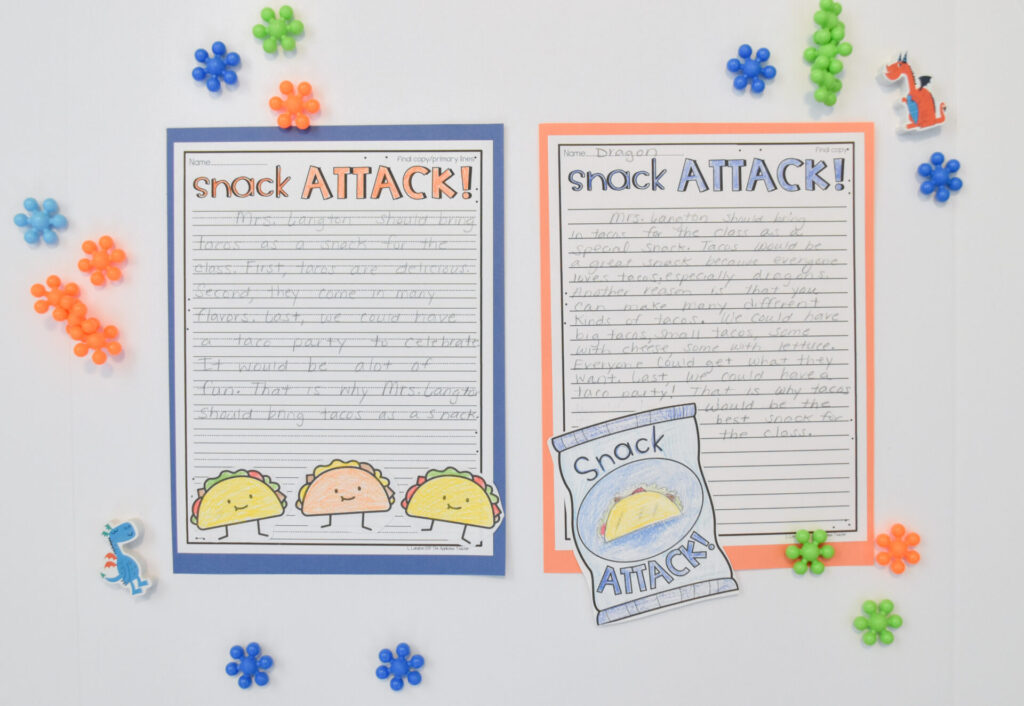
In Snack Attack! Students will write a persuasive essay convincing their teacher to provide a preferred snack to the class. This writing project will help your students write a persuasive essay using:
- A clear position statement
- Evidence or details to support their position
I promise your students will love this persuasive writing!
Suggested Books for Persuasive Writing in 2nd Grade
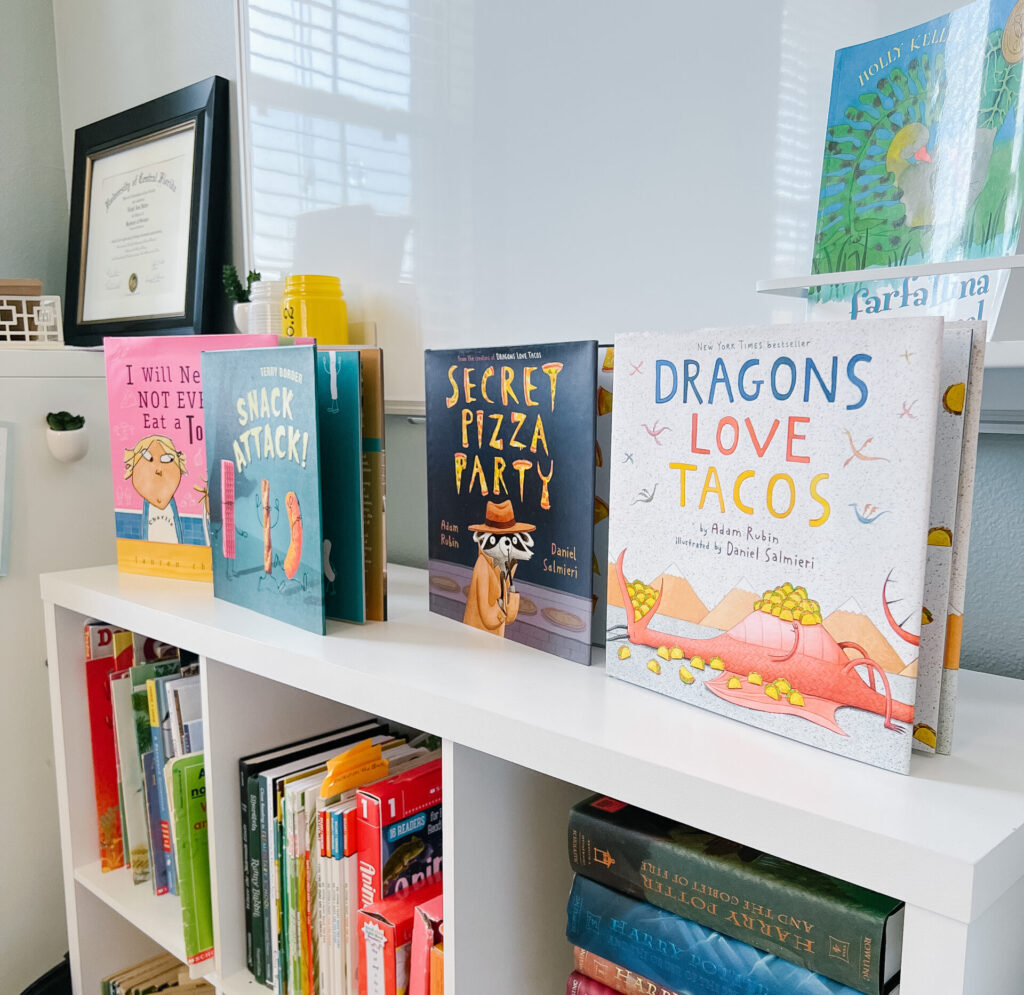
When teaching a new topic, I love using resources that will provide my students with some background knowledge. There are two books I highly recommend that will help spark the conversation of persuasion with your students.
The first book is Dragon Loves Tacos by Adam Rubin . This deliciously funny read-aloud is an unforgettable story about new friends and the perfect snack that will have your students laughing until spicy salsa comes out of their noses!
The second book I recommend is also by Adam Rubin. Secret Pizza Party is about a raccoon who loves pizza! However, someone is always chasing the poor raccoon away from his favorite food. What does he decide to do? Plan an elaborate secret pizza party, of course!
Both books are great ways to discuss how the author uses details to support their claims with your students.
Here are a few other books that would work for this writing activity, too:
- Dragon Loves Tacos
- Secret Pizza Party
- Snack Attack
- I Will Never, Not Ever, Eat a Tomato
Brainstorming Ideas
After reading the story, it’s time to introduce the writing! Tell students that they’ll be working on writing a persuasive piece where they’re trying to persuade YOU to bring in a snack for THEM!
From there, brainstorm some snacks that would be class appropriate. Write the snack suggestions the class comes up with on the board. Then, have students choose which snack they’d like to write about. Send them back to their seat to brainstorm why that snack would be perfect for you to bring into class.
This resource includes a brainstorming sheet. They can work through their thoughts which is a great way to help students zero in on their snack position. Students can also begin to develop details to support their opinion. The brainstorming sheet is super easy to follow and is a great visual for students when planning out their thoughts.
Teacher Note: I suggest you model how to fill out a brainstorming sheet as the students fill in theirs. This can be incredibly helpful for early and emerging writers.
Writing a Rough Draft
Now it’s time for the rough draft.
When your students begin to write their rough draft, it is important to remind them to use their brainstorming sheet as a guide. You will want to model for your students so that they understand the expectations. Follow these steps:
- Model how an introduction helps tell the reader what the author is writing about
- Use the brainstorm sheet to write an introduction sentence
- Then, model how to use details- remind students to use capital letters and ending punctuation as they write. Model rereading writing for clarity.
- Add a conclusion and discuss how a conclusion helps “sum up” the writing
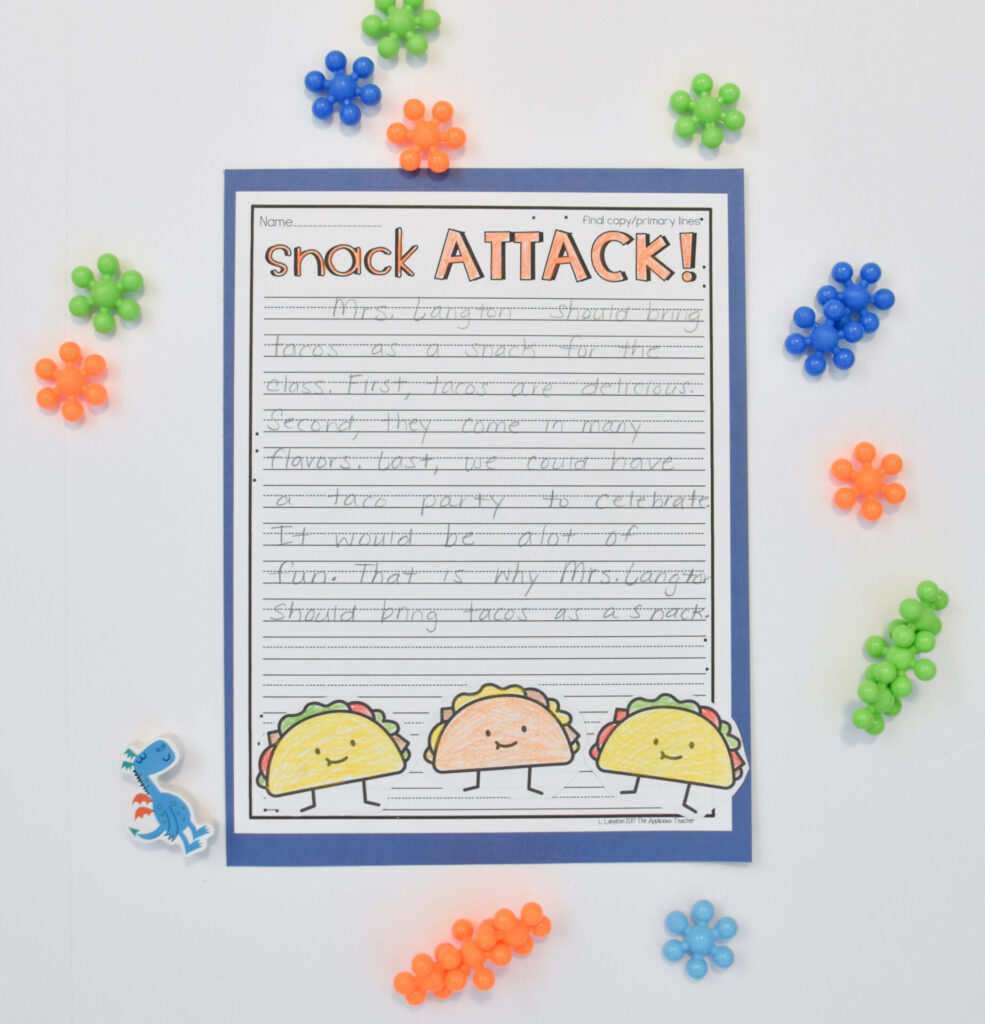
Using a Rubric for Editing
This is one of my favorite things about this resource! Students will use a self-checking rubric which helps them learn the editing process. I always like to begin by discussing how to use the rubric. It is also a great way for your students to ensure their writing has all of its pieces. There are many ways you can have your students edit their writing pieces. For example, using the rubric, students can check over their writing independently or pair up with a partner who can share their opinion or make suggestions.
Revise and Rewrite
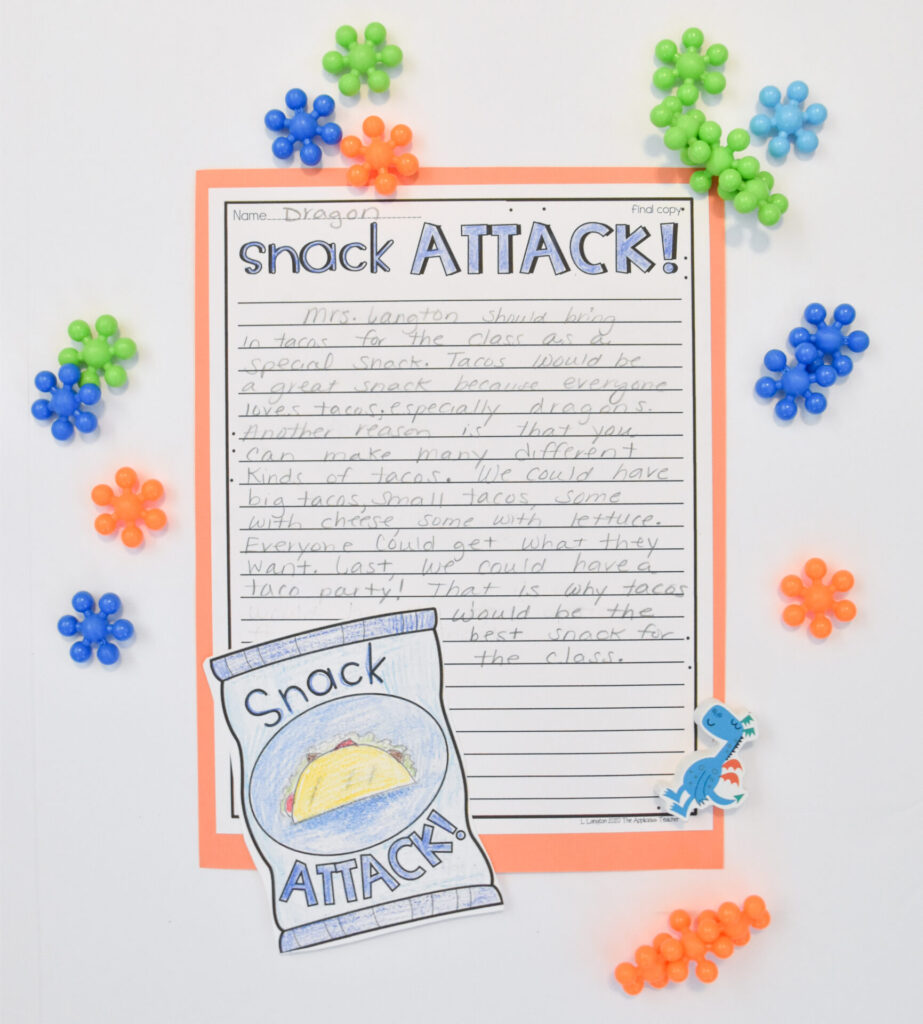
After students have had the opportunity to edit their writing, they can begin writing their final draft. During the rewriting process, I like to remind my kiddos that they are still using their self-checking rubric as a guide. They can also use any recommendations given by their partner. When students are ready to publish, I give them the special writing page included in this resource. They also get the opportunity to create a craft. As a final step, students should attach their rubric to the back of their persuasive writing piece.
Voting for the Best Snack
One of the best ways to increase student engagement with this writing activity is to actually buy the winning essay’s snack suggestion. I love making this part a friendly competition! First, have your students share their writing pieces in small groups. While your students are reading, you will want to circulate around the room to find 4-5 most convincing details. Have each student read their writing piece to the class and have your students vote on the best one. I would recommend using a blind voting system with two levels (5 essays, to 3, then 1). Last but not least, bring in that special snack for the class to share!
Free Persuasive Writing Resource
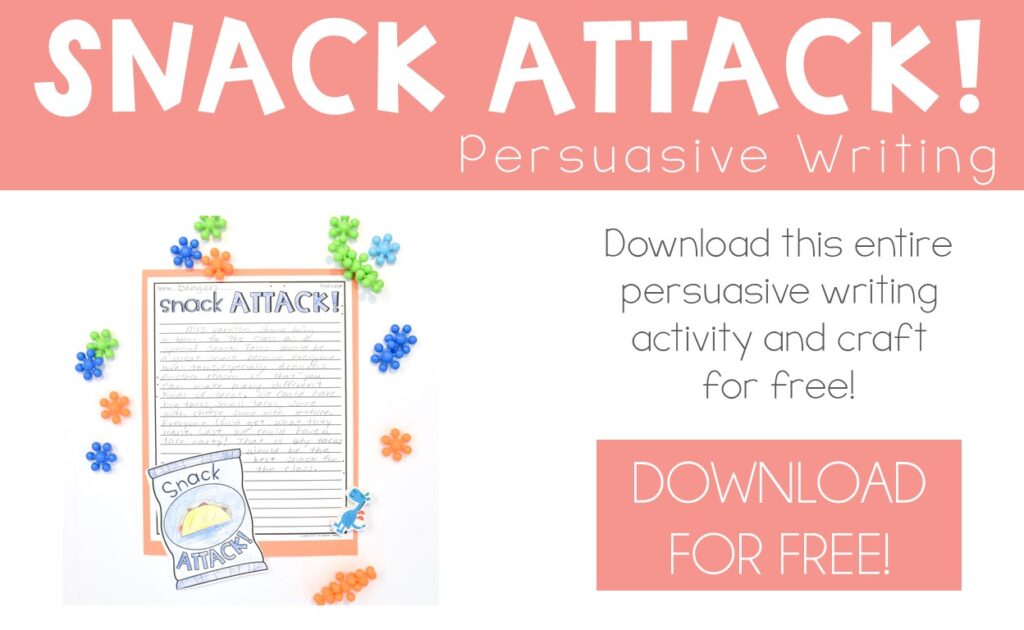
Now that you know all about this wonderful resource, I have some good news! Just add your email to the form, and you’ll get this entire product for FREE! I know this resource will be extremely helpful when teaching your students about persuasive writing. Not to mention that they will be highly engaged and excited to write!
So, tell me, what is one of your favorite parts of this resource? Or do you love it all? Comment below and share your thoughts!
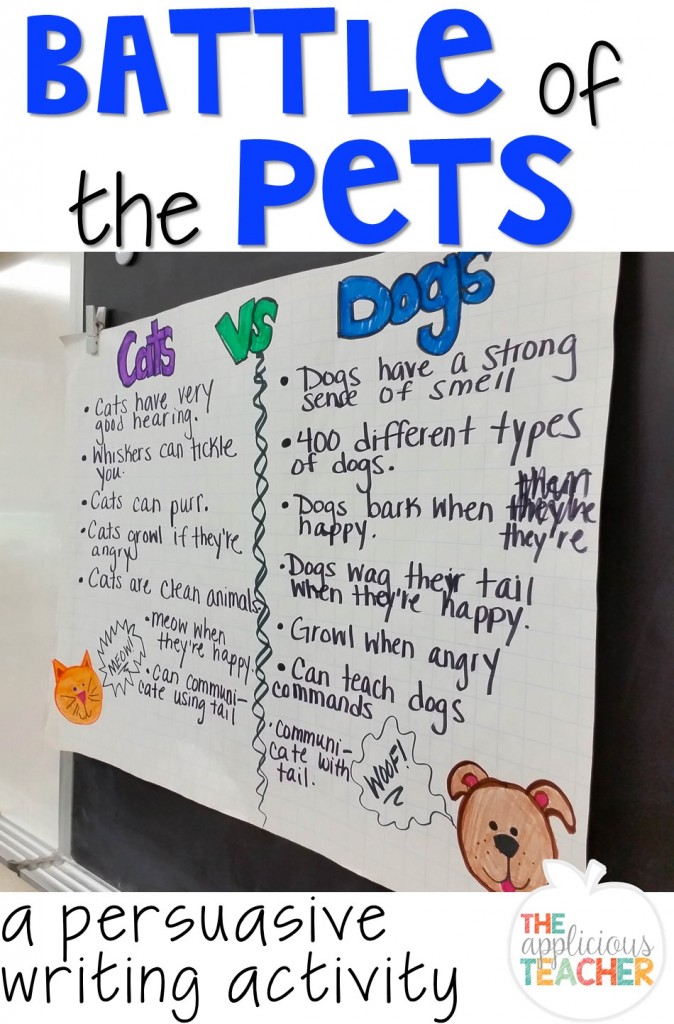
Related Posts
- 5 Day Writing Routine: Guaranteed to Make Better Writers
- Persuasive Writing: the Battle of the Pets
All About My Selfie An About Me Back to School Writing Activity
- 3 Simple Ways to Get Students Excited About Writing
Sign up to snag these!

Receive all these classroom management tools right to your inbox!
Success! Now check your email to confirm your subscription.
There was an error submitting your subscription. Please try again.
- Categories: 2nd Grade , FREEBIE , student engagement , writing

Hi, I'm Leigh.
The Applicious Teacher is all about creating hands-on and engaging lessons that align with the standards while still having time for your life. This is your place for ideas, tips, and resources for the REAL teacher!
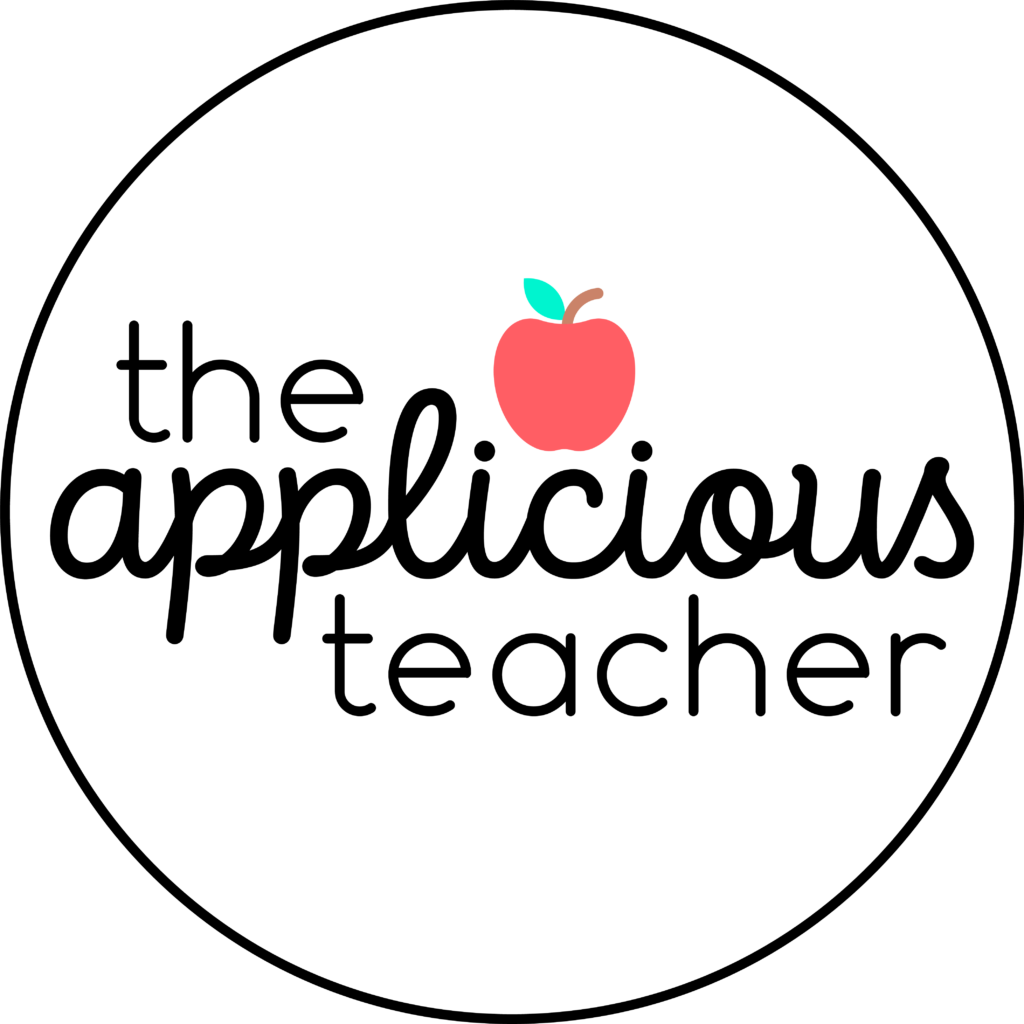
Recent Posts
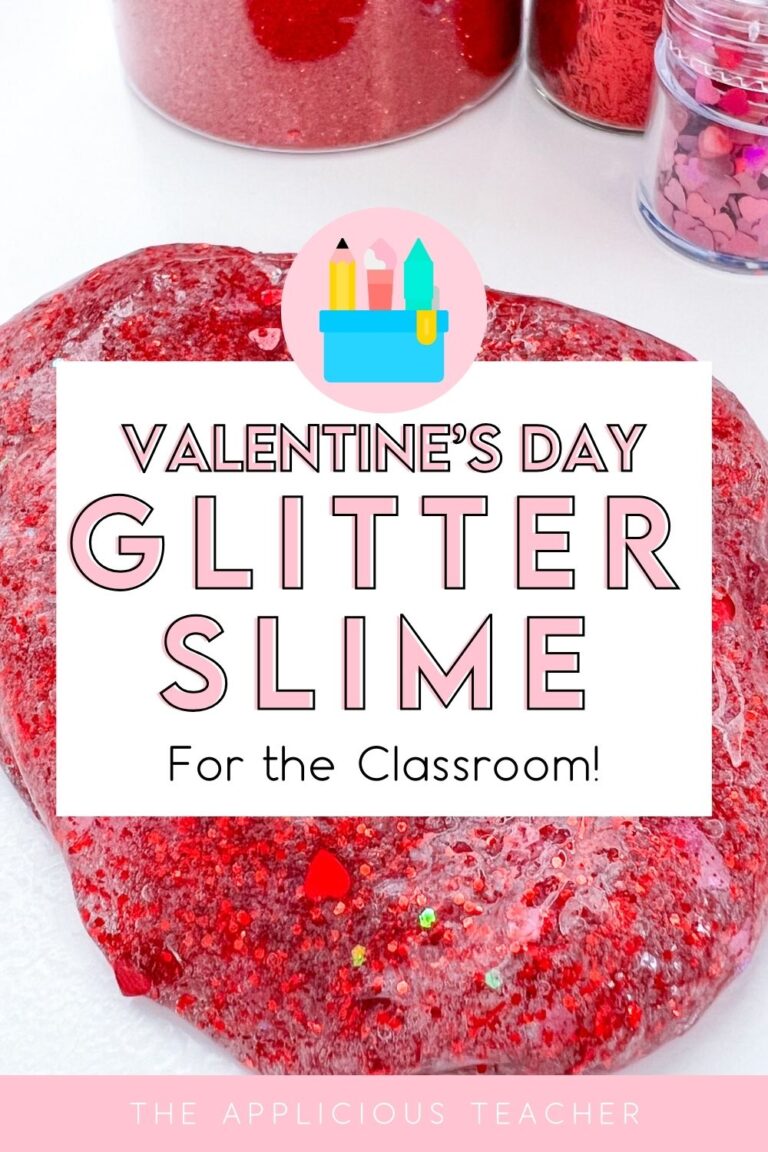
Popular in the Store
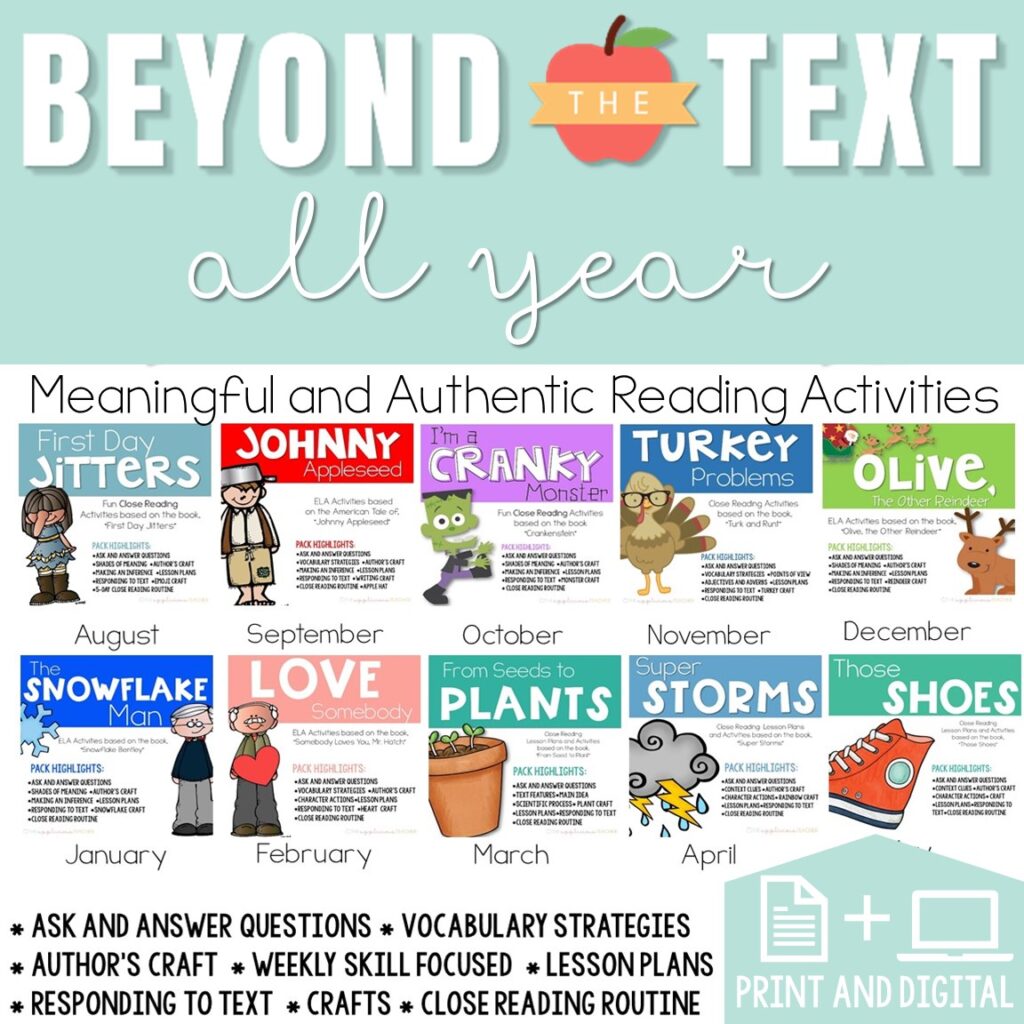
You may also enjoy...
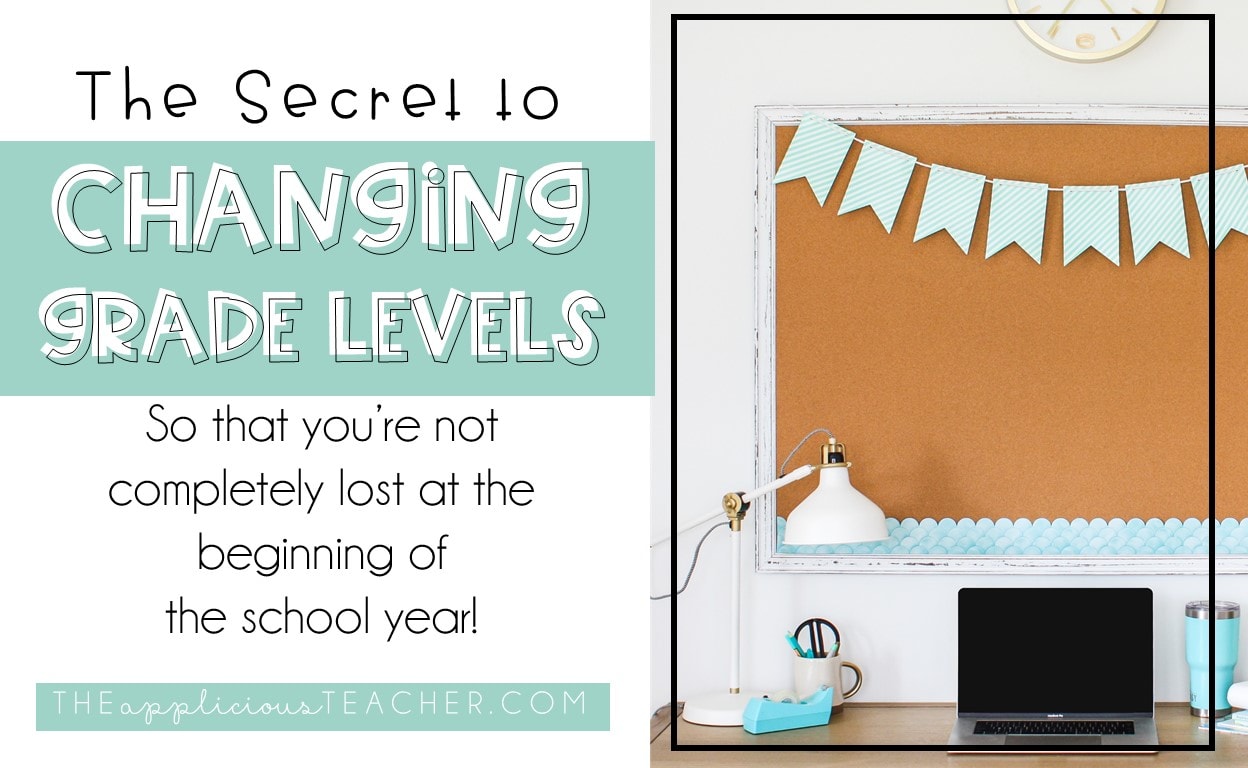
Tips for Changing Grade Levels
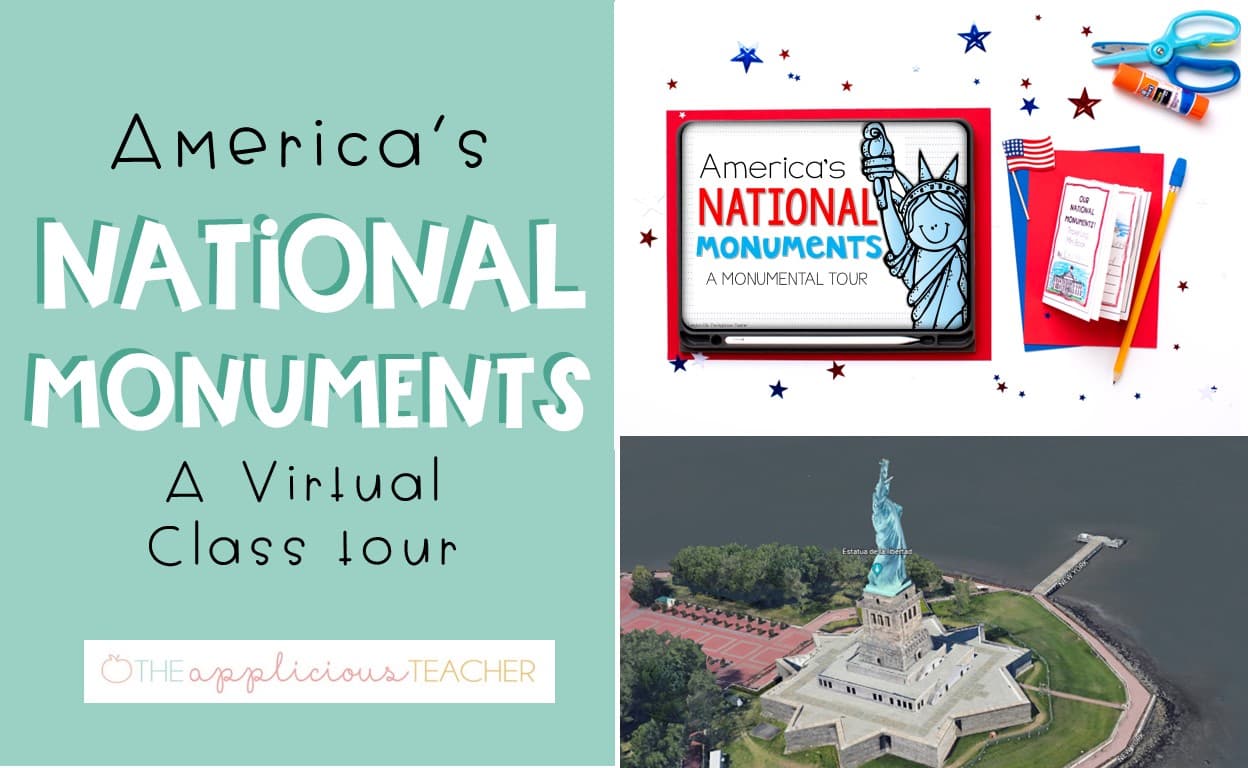
National Monuments Activities: Taking Students on a Monumental Tour
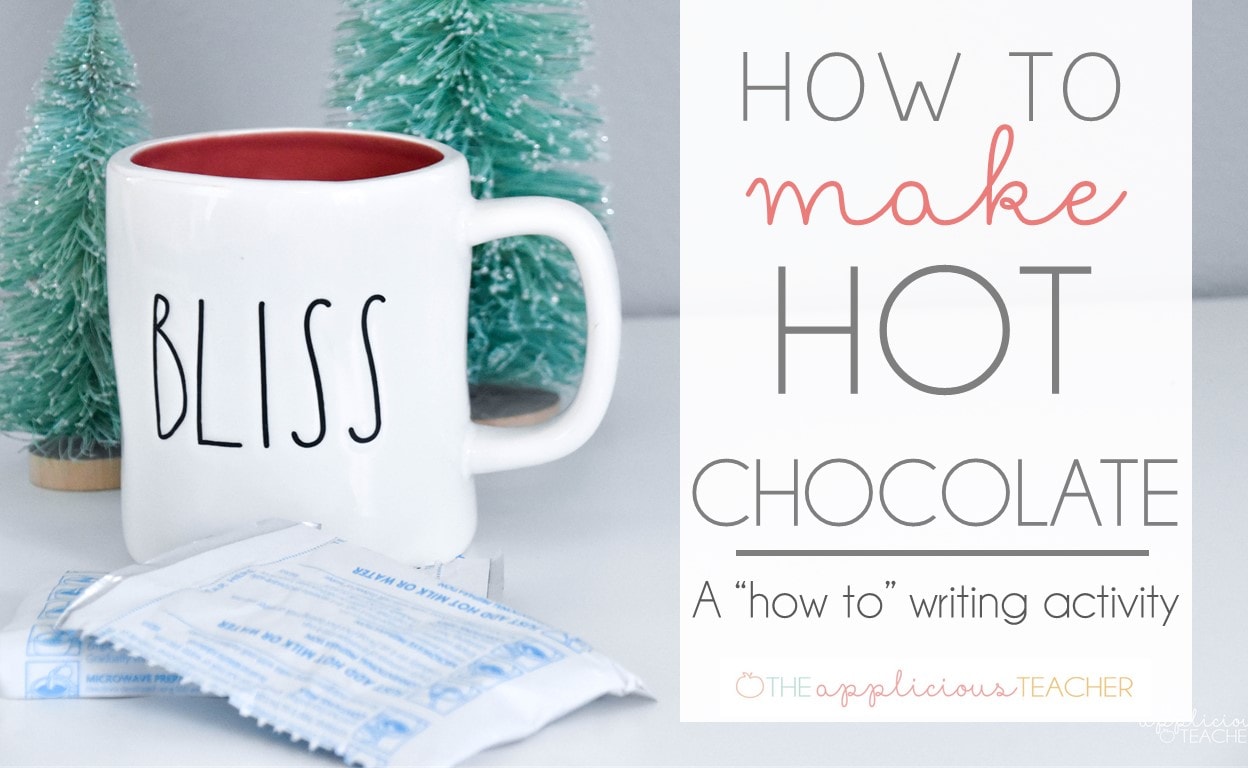
How to Writing: How to Make Hot Chocolate Writing Activity and Craft
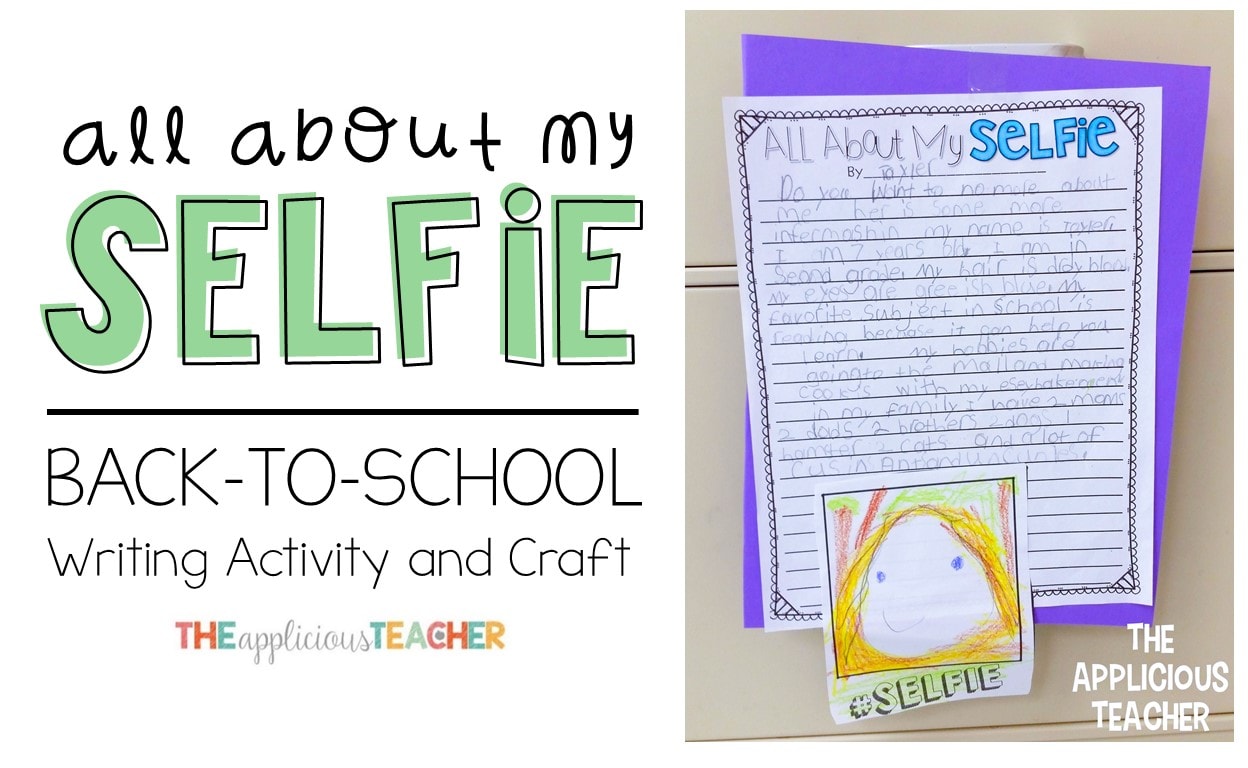
© 2021 The Applicious Teacher. All Rights Reserved
Designed by Ashley Hughes
Use of Cookies
Privacy overview.
Teaching Second Grade Essay Writing
Christopher cascio, 26 sep 2017.

The Common Core State Standards Initiative suggests that second graders write short, simplified essays that include elements like introduction, body, conclusion, description and even argument. You can teach all of this by focusing on the writing process -- or a simplified version of it -- as the framework for instruction. Doing so stresses the most important lesson: writing is about organizing your thoughts and setting them to paper.
Explore this article
- Understanding the Mode
- Brainstorming
1 Understanding the Mode
The first step of the writing process, understanding the mode, must not be ignored. Students need to know the differences of writing an opinion piece (an argument), a narrative (a short story), or an expository essay (a book report). By focusing on the needs of each type of assignment, you can teach the techniques used most effectively in each. Explain the importance of details in stories or how written arguments need to give reasons to support opinions. Writing book reports gives you the opportunity to teach them some sentence-level techniques, such as using time-related words to indicate the orders of events.
2 Brainstorming
Students must understand the importance of getting their thoughts onto paper, so they can actually see all of their options instead of trying to remember them all. Start by asking them to make one list of all the things they know about their topics (At this grade, you can assign topics.). Then you can have them write separate lists that start to organize their thoughts, perhaps by chronology: things that happen in the beginning, then the middle, then the end; or separate lists of facts and opinions. As they progress, continue to encourage specificity and finer levels of organization.
3 Outlining
Outlining is a step students routinely resist, especially those who don't like writing to begin with. Explain that outlining is a blueprint for their essays and a step that will make finishing the assignment that much easier. Suggest the analogy of constructing a house. They wouldn't start building a house without a good plan, would they? When they understand the helpfulness of outlining, they will appreciate that help. Furthermore, seeing their essays taking shape as sequences of ideas provides the opportunity to teach basic transition words and phrases.
As they come to the point when they write their first drafts, you'll want to review the characteristics of good, simple sentences. Review punctuation and the importance of specific nouns and active verbs. For students who don't like writing, suggest they just follow their outlines, step by step. For those who enjoy it, let them write freely so they might find a passion for the art. The remaining mechanics and rhetorical strategies you wish to teach are accomplished while students edit their work, which you should do individually and in the presence of each student, if possible.
As much as students might not like it, they have to learn that revision is an important part of writing. To keep the mood positive, explain revision as an opportunity to make their essays better, as opposed to a time when they have to fix mistakes. This is also an opportunity to teach them the importance of reading their work aloud so they can hear their writing voices. Writing short stories might be especially suitable for this exercise.
- 1 Common Core State Standards Initiative: English Language Arts Standards: Writing: Grade 2
- 2 Purdue OWL: Introduction to Prewriting (Invention)
- 3 Purdue OWL: Why and How to Create a Useful Outline
About the Author
Christopher Cascio is a memoirist and holds a Master of Fine Arts in creative writing and literature from Southampton Arts at Stony Brook Southampton, and a Bachelor of Arts in English with an emphasis in the rhetoric of fiction from Pennsylvania State University. His literary work has appeared in "The Southampton Review," "Feathertale," "Kalliope" and "The Rose and Thorn Journal."
Related Articles

How to Teach Persuasive Writing to Fourth Grade

A Simple Way to Teach Third-Graders How to Write a...

What Skills Must a Student Develop to Write an Effective...

Elements of Writing for Fifth Grade

How to Write an Introduction for a Character Analysis

Teaching 4th Graders to Write a Biography

8 Steps in Writing a Process Paragraph

Types of High School English Classes

Writing Exercises for High School

Task Anaylsis for Math Problems

How to Teach Writing to Autistic Children

Narrative Writing Activities for ESL

How to Use Contractions in a College Essay

How to Improve Writing Skills for Sixth Graders

Teaching Creative Writing to 2nd Graders

Different Ways to Write Down Notes in a Classroom

Directions for Outlining a Textbook Chapter

Activities for Dysgraphia


Lesson Plan Ideas for Teaching Point of View for Middle...

How to Write an Analytical Paragraph
Regardless of how old we are, we never stop learning. Classroom is the educational resource for people of all ages. Whether you’re studying times tables or applying to college, Classroom has the answers.
- Accessibility
- Terms of Use
- Privacy Policy
- Copyright Policy
- Manage Preferences
© 2020 Leaf Group Ltd. / Leaf Group Media, All Rights Reserved. Based on the Word Net lexical database for the English Language. See disclaimer .
- Grades 6-12
- School Leaders
FREE Book Bracket Template. For March and Beyond!
40 Strong Persuasive Writing Examples (Essays, Speeches, Ads, and More)
Learn from the experts.

The more we read, the better writers we become. Teaching students to write strong persuasive essays should always start with reading some top-notch models. This round-up of persuasive writing examples includes famous speeches, influential ad campaigns, contemporary reviews of famous books, and more. Use them to inspire your students to write their own essays. (Need persuasive essay topics? Check out our list of interesting persuasive essay ideas here! )
- Persuasive Essays
- Persuasive Speeches
- Advertising Campaigns
Persuasive Essay Writing Examples

From the earliest days of print, authors have used persuasive essays to try to sway others to their own point of view. Check out these top persuasive essay writing examples.
Professions for Women by Virginia Woolf
Sample lines: “Outwardly, what is simpler than to write books? Outwardly, what obstacles are there for a woman rather than for a man? Inwardly, I think, the case is very different; she has still many ghosts to fight, many prejudices to overcome. Indeed it will be a long time still, I think, before a woman can sit down to write a book without finding a phantom to be slain, a rock to be dashed against. And if this is so in literature, the freest of all professions for women, how is it in the new professions which you are now for the first time entering?”
The Crisis by Thomas Paine
Sample lines: “These are the times that try men’s souls. The summer soldier and the sunshine patriot will, in this crisis, shrink from the service of their country; but he that stands by it now, deserves the love and thanks of man and woman. Tyranny, like hell, is not easily conquered; yet we have this consolation with us, that the harder the conflict, the more glorious the triumph. What we obtain too cheap, we esteem too lightly: it is dearness only that gives every thing its value.”
Politics and the English Language by George Orwell
Sample lines: “As I have tried to show, modern writing at its worst does not consist in picking out words for the sake of their meaning and inventing images in order to make the meaning clearer. It consists in gumming together long strips of words which have already been set in order by someone else, and making the results presentable by sheer humbug.”
Letter From a Birmingham Jail by Dr. Martin Luther King Jr.
Sample lines: “We know through painful experience that freedom is never voluntarily given by the oppressor; it must be demanded by the oppressed. Frankly, I have yet to engage in a direct action campaign that was ‘well timed’ in the view of those who have not suffered unduly from the disease of segregation. For years now I have heard the word ‘Wait!’ It rings in the ear of every Negro with piercing familiarity. This ‘Wait’ has almost always meant ‘Never.’ We must come to see, with one of our distinguished jurists, that ‘justice too long delayed is justice denied.'”
Civil Disobedience by Henry David Thoreau
Sample lines: “Even voting for the right is doing nothing for it. It is only expressing to men feebly your desire that it should prevail. A wise man will not leave the right to the mercy of chance, nor wish it to prevail through the power of the majority. There is but little virtue in the action of masses of men.”
Go Gentle Into That Good Night by Roger Ebert
Sample lines: “‘Kindness’ covers all of my political beliefs. No need to spell them out. I believe that if, at the end of it all, according to our abilities, we have done something to make others a little happier, and something to make ourselves a little happier, that is about the best we can do. To make others less happy is a crime.”
The Way to Wealth by Benjamin Franklin
Sample lines: “Methinks I hear some of you say, must a man afford himself no leisure? I will tell thee, my friend, what Poor Richard says, employ thy time well if thou meanest to gain leisure; and, since thou art not sure of a minute, throw not away an hour. Leisure is time for doing something useful; this leisure the diligent man will obtain, but the lazy man never; so that, as Poor Richard says, a life of leisure and a life of laziness are two things.”
The Crack-Up by F. Scott Fitzgerald
Sample lines: “Of course all life is a process of breaking down, but the blows that do the dramatic side of the work—the big sudden blows that come, or seem to come, from outside—the ones you remember and blame things on and, in moments of weakness, tell your friends about, don’t show their effect all at once.”
Open Letter to the Kansas School Board by Bobby Henderson
Sample lines: “I am writing you with much concern after having read of your hearing to decide whether the alternative theory of Intelligent Design should be taught along with the theory of Evolution. … Let us remember that there are multiple theories of Intelligent Design. I and many others around the world are of the strong belief that the universe was created by a Flying Spaghetti Monster. … We feel strongly that the overwhelming scientific evidence pointing towards evolutionary processes is nothing but a coincidence, put in place by Him. It is for this reason that I’m writing you today, to formally request that this alternative theory be taught in your schools, along with the other two theories.”
Open Letter to the United Nations by Niels Bohr
Sample lines: “Humanity will, therefore, be confronted with dangers of unprecedented character unless, in due time, measures can be taken to forestall a disastrous competition in such formidable armaments and to establish an international control of the manufacture and use of the powerful materials.”
Persuasive Speech Writing Examples
Many persuasive speeches are political in nature, often addressing subjects like human rights. Here are some of history’s most well-known persuasive writing examples in the form of speeches.
I Have a Dream by Dr. Martin Luther King Jr.
Sample lines: “And so even though we face the difficulties of today and tomorrow, I still have a dream. It is a dream deeply rooted in the American dream. I have a dream that one day this nation will rise up and live out the true meaning of its creed: We hold these truths to be self-evident, that all men are created equal.”
Woodrow Wilson’s War Message to Congress, 1917
Sample lines: “There are, it may be, many months of fiery trial and sacrifice ahead of us. It is a fearful thing to lead this great peaceful people into war, into the most terrible and disastrous of all wars, civilization itself seeming to be in the balance. But the right is more precious than peace, and we shall fight for the things which we have always carried nearest our hearts—for democracy, for the right of those who submit to authority to have a voice in their own governments, for the rights and liberties of small nations, for a universal dominion of right by such a concert of free peoples as shall bring peace and safety to all nations and make the world itself at last free.”
Chief Seattle’s 1854 Oration
Sample lines: “I here and now make this condition that we will not be denied the privilege without molestation of visiting at any time the tombs of our ancestors, friends, and children. Every part of this soil is sacred in the estimation of my people. Every hillside, every valley, every plain and grove, has been hallowed by some sad or happy event in days long vanished. Even the rocks, which seem to be dumb and dead as they swelter in the sun along the silent shore, thrill with memories of stirring events connected with the lives of my people, and the very dust upon which you now stand responds more lovingly to their footsteps than yours, because it is rich with the blood of our ancestors, and our bare feet are conscious of the sympathetic touch.”
Women’s Rights Are Human Rights, Hillary Rodham Clinton
Sample lines: “What we are learning around the world is that if women are healthy and educated, their families will flourish. If women are free from violence, their families will flourish. If women have a chance to work and earn as full and equal partners in society, their families will flourish. And when families flourish, communities and nations do as well. … If there is one message that echoes forth from this conference, let it be that human rights are women’s rights and women’s rights are human rights once and for all.”
I Am Prepared to Die, Nelson Mandela
Sample lines: “Above all, My Lord, we want equal political rights, because without them our disabilities will be permanent. I know this sounds revolutionary to the whites in this country, because the majority of voters will be Africans. This makes the white man fear democracy. But this fear cannot be allowed to stand in the way of the only solution which will guarantee racial harmony and freedom for all. It is not true that the enfranchisement of all will result in racial domination. Political division, based on color, is entirely artificial and, when it disappears, so will the domination of one color group by another. … This then is what the ANC is fighting. Our struggle is a truly national one. It is a struggle of the African people, inspired by our own suffering and our own experience. It is a struggle for the right to live.”
The Struggle for Human Rights by Eleanor Roosevelt
Sample lines: “It is my belief, and I am sure it is also yours, that the struggle for democracy and freedom is a critical struggle, for their preservation is essential to the great objective of the United Nations to maintain international peace and security. Among free men the end cannot justify the means. We know the patterns of totalitarianism—the single political party, the control of schools, press, radio, the arts, the sciences, and the church to support autocratic authority; these are the age-old patterns against which men have struggled for 3,000 years. These are the signs of reaction, retreat, and retrogression. The United Nations must hold fast to the heritage of freedom won by the struggle of its people; it must help us to pass it on to generations to come.”
Freedom From Fear by Aung San Suu Kyi
Sample lines: “Saints, it has been said, are the sinners who go on trying. So free men are the oppressed who go on trying and who in the process make themselves fit to bear the responsibilities and to uphold the disciplines which will maintain a free society. Among the basic freedoms to which men aspire that their lives might be full and uncramped, freedom from fear stands out as both a means and an end. A people who would build a nation in which strong, democratic institutions are firmly established as a guarantee against state-induced power must first learn to liberate their own minds from apathy and fear.”
Harvey Milk’s “The Hope” Speech
Sample lines: “Some people are satisfied. And some people are not. You see there is a major difference—and it remains a vital difference—between a friend and a gay person, a friend in office and a gay person in office. Gay people have been slandered nationwide. We’ve been tarred and we’ve been brushed with the picture of pornography. In Dade County, we were accused of child molestation. It is not enough anymore just to have friends represent us, no matter how good that friend may be.”
The Union and the Strike, Cesar Chavez
Sample lines: “We are showing our unity in our strike. Our strike is stopping the work in the fields; our strike is stopping ships that would carry grapes; our strike is stopping the trucks that would carry the grapes. Our strike will stop every way the grower makes money until we have a union contract that guarantees us a fair share of the money he makes from our work! We are a union and we are strong and we are striking to force the growers to respect our strength!”
Nobel Lecture by Malala Yousafzai
Sample lines: “The world can no longer accept that basic education is enough. Why do leaders accept that for children in developing countries, only basic literacy is sufficient, when their own children do homework in algebra, mathematics, science, and physics? Leaders must seize this opportunity to guarantee a free, quality, primary and secondary education for every child. Some will say this is impractical, or too expensive, or too hard. Or maybe even impossible. But it is time the world thinks bigger.”
Persuasive Writing Examples in Advertising Campaigns
Ads are prime persuasive writing examples. You can flip open any magazine or watch TV for an hour or two to see sample after sample of persuasive language. Here are some of the most popular ad campaigns of all time, with links to articles explaining why they were so successful.
Nike: Just Do It

The iconic swoosh with the simple tagline has persuaded millions to buy their kicks from Nike and Nike alone. Teamed with pro sports-star endorsements, this campaign is one for the ages. Blinkist offers an opinion on what made it work.
Dove: Real Beauty
Beauty brand Dove changed the game by choosing “real” women to tell their stories instead of models. They used relatable images and language to make connections, and inspired other brands to try the same concept. Learn why Global Brands considers this one a true success story.
Wendy’s: Where’s the Beef?
Today’s kids are too young to remember the cranky old woman demanding to know where the beef was on her fast-food hamburger. But in the 1980s, it was a catchphrase that sold millions of Wendy’s burgers. Learn from Better Marketing how this ad campaign even found its way into the 1984 presidential debate.
De Beers: A Diamond Is Forever

A diamond engagement ring has become a standard these days, but the tradition isn’t as old as you might think. In fact, it was De Beers jewelry company’s 1948 campaign that created the modern engagement ring trend. The Drum has the whole story of this sparkling campaign.
Volkswagen: Think Small
Americans have always loved big cars. So in the 1960s, when Volkswagen wanted to introduce their small cars to a bigger market, they had a problem. The clever “Think Small” campaign gave buyers clever reasons to consider these models, like “If you run out of gas, it’s easy to push.” Learn how advertisers interested American buyers in little cars at Visual Rhetoric.
American Express: Don’t Leave Home Without It
AmEx was once better known for traveler’s checks than credit cards, and the original slogan was “Don’t leave home without them.” A simple word change convinced travelers that American Express was the credit card they needed when they headed out on adventures. Discover more about this persuasive campaign from Medium.
Skittles: Taste the Rainbow

These candy ads are weird and intriguing and probably not for everyone. But they definitely get you thinking, and that often leads to buying. Learn more about why these wacky ads are successful from The Drum.
Maybelline: Maybe She’s Born With It
Smart wordplay made this ad campaign slogan an instant hit. The ads teased, “Maybe she’s born with it. Maybe it’s Maybelline.” (So many literary devices all in one phrase!) Fashionista has more on this beauty campaign.
Coca-Cola: Share a Coke
Seeing their own name on a bottle made teens more likely to want to buy a Coke. What can that teach us about persuasive writing in general? It’s an interesting question to consider. Learn more about the “Share a Coke” campaign from Digital Vidya.
Always: #LikeaGirl

Talk about the power of words! This Always campaign turned the derogatory phrase “like a girl” on its head, and the world embraced it. Storytelling is an important part of persuasive writing, and these ads really do it well. Medium has more on this stereotype-bashing campaign.
Editorial Persuasive Writing Examples

Newspaper editors or publishers use editorials to share their personal opinions. Noted politicians, experts, or pundits may also offer their opinions on behalf of the editors or publishers. Here are a couple of older well-known editorials, along with a selection from current newspapers.
Yes, Virginia, There Is a Santa Claus (1897)
Sample lines: “Yes, Virginia, there is a Santa Claus. He exists as certainly as love and generosity and devotion exist, and you know that they abound and give to your life its highest beauty and joy. Alas! How dreary would be the world if there were no Santa Claus. It would be as dreary as if there were no Virginias.”
What’s the Matter With Kansas? (1896)
Sample lines: “Oh, this IS a state to be proud of! We are a people who can hold up our heads! What we need is not more money, but less capital, fewer white shirts and brains, fewer men with business judgment, and more of those fellows who boast that they are ‘just ordinary clodhoppers, but they know more in a minute about finance than John Sherman,’ we need more men … who hate prosperity, and who think, because a man believes in national honor, he is a tool of Wall Street.”
America Can Have Democracy or Political Violence. Not Both. (The New York Times)
Sample lines: “The nation is not powerless to stop a slide toward deadly chaos. If institutions and individuals do more to make it unacceptable in American public life, organized violence in the service of political objectives can still be pushed to the fringes. When a faction of one of the country’s two main political parties embraces extremism, that makes thwarting it both more difficult and more necessary. A well-functioning democracy demands it.”
The Booster Isn’t Perfect, But Still Can Help Against COVID (The Washington Post)
Sample lines: “The booster shots are still free, readily available and work better than the previous boosters even as the virus evolves. Much still needs to be done to build better vaccines that protect longer and against more variants, including those that might emerge in the future. But it is worth grabbing the booster that exists today, the jab being a small price for any measure that can help keep COVID at bay.”
If We Want Wildlife To Thrive in L.A., We Have To Share Our Neighborhoods With Them (Los Angeles Times)
Sample lines: “If there are no corridors for wildlife movement and if excessive excavation of dirt to build bigger, taller houses erodes the slope of a hillside, then we are slowly destroying wildlife habitat. For those people fretting about what this will do to their property values—isn’t open space, trees, and wildlife an amenity in these communities?”
Persuasive Review Writing Examples

Book or movie reviews are more great persuasive writing examples. Look for those written by professionals for the strongest arguments and writing styles. Here are reviews of some popular books and movies by well-known critics to use as samples.
The Great Gatsby (The Chicago Tribune, 1925)
Sample lines: “What ails it, fundamentally, is the plain fact that it is simply a story—that Fitzgerald seems to be far more interested in maintaining its suspense than in getting under the skins of its people. It is not that they are false: It is that they are taken too much for granted. Only Gatsby himself genuinely lives and breathes. The rest are mere marionettes—often astonishingly lifelike, but nevertheless not quite alive.”
Harry Potter and the Sorcerer’s Stone (The Washington Post, 1999)
Sample lines: “Obviously, Harry Potter and the Sorcerer’s Stone should make any modern 11-year-old a very happy reader. The novel moves quickly, packs in everything from a boa constrictor that winks to a melancholy Zen-spouting centaur to an owl postal system, and ends with a scary surprise. Yet it is, essentially, a light-hearted thriller, interrupted by occasional seriousness (the implications of Harry’s miserable childhood, a moral about the power of love).”
Twilight (The Telegraph, 2009)
Sample lines: “No secret, of course, at whom this book is aimed, and no doubt, either, that it has hit its mark. The four Twilight novels are not so much enjoyed, as devoured, by legions of young female fans worldwide. That’s not to say boys can’t enjoy these books; it’s just that the pages of heart-searching dialogue between Edward and Bella may prove too long on chat and too short on action for the average male reader.”
To Kill a Mockingbird (Time, 1960)
Sample lines: “Author Lee, 34, an Alabaman, has written her first novel with all of the tactile brilliance and none of the preciosity generally supposed to be standard swamp-warfare issue for Southern writers. The novel is an account of an awakening to good and evil, and a faint catechistic flavor may have been inevitable. But it is faint indeed; novelist Lee’s prose has an edge that cuts through cant, and she teaches the reader an astonishing number of useful truths about little girls and about Southern life.”
The Diary of Anne Frank (The New York Times, 1952)
Sample lines: “And this quality brings it home to any family in the world today. Just as the Franks lived in momentary fear of the Gestapo’s knock on their hidden door, so every family today lives in fear of the knock of war. Anne’s diary is a great affirmative answer to the life-question of today, for she shows how ordinary people, within this ordeal, consistently hold to the greater human values.”
What are your favorite persuasive writing examples to use with students? Come share your ideas in the WeAreTeachers HELPLINE group on Facebook .
Plus, the big list of essay topics for high school (120+ ideas) ..

You Might Also Like

101 Interesting Persuasive Essay Topics for Kids and Teens
Use your words to sway the reader. Continue Reading
Copyright © 2023. All rights reserved. 5335 Gate Parkway, Jacksonville, FL 32256
- Testimonials

Writing a second grade essay
In elementary school, children need to compose four kinds of passages:
- Short responses to questions (one or two sentences),
- Long responses to questions (about five sentences or one paragraph),
- Narratives (stories of varying lengths), and
- Essays (single paragraphs to five paragraphs).
The other night I received a call from a father whose second-grade son needed to write an essay on his favorite animal. The child didn’t know what to do. I asked the boy on the phone what his favorite animal is. “Dogs,” he said, not a surprising answer since the boy has grown up with pet dogs. I asked him why, and he identified several reasons. I told him he needed to explain his reasons. He told me that without problem.
I told him that to write the essay he needed to
- First, write a sentence saying that dogs are his favorite animal.
- Second, tell why dogs are his favorite animal, one sentence for each reason. Then he needed to add other sentences explaining why. The best detail is one that begins with “for example,” I told him.
- Last, end the essay by repeating that dogs are his favorite animal and name the reasons without the details.
Do you understand? I asked. The boy grumbled in the background, but his father told me that he understood. We ended the phone conversation.
The next morning, the father texted me the essay below.
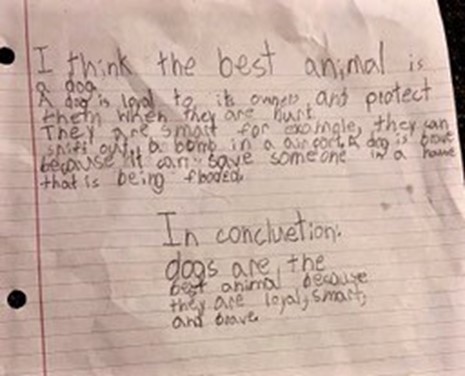
I don’t know how much direction the classroom teacher gave this boy. It seemed like this was one of the first times the student was required to write an essay. Did the teacher take the students through the organizational process? Did she show organizational boxes for the student to fill in? Did she model writing an essay or two or three in class? Did she explain what information belonged in the first sentence or in the middle sentences or in the conclusion? I suspect she didn’t since the boy—an A+ student—had no idea when I talked to him. Yet after a five-minute phone call, he wrote a classic essay (for a second grader).
To be fair, I don’t know the circumstances surrounding this assignment. Was the teacher a substitute? Was there a fire drill taking up the time that the teacher wanted to use to preview this assignment? Was the boy pulled out of class when the teacher explained the assignment to the class?
I am left to wonder what training this boy’s teacher received to teach writing. Perhaps, like all too many teachers, not enough.
Share this:
- Click to share on Facebook (Opens in new window)
- Click to share on Pinterest (Opens in new window)
- Click to share on Twitter (Opens in new window)
- Click to email a link to a friend (Opens in new window)
What's your thinking on this topic? Cancel reply
One-on-one online writing improvement for students of all ages.

As a professional writer and former certified middle and high school educator, I now teach writing skills online. I coach students of all ages on the practices of writing. Click on my photo for more details.

You may think revising means finding grammar and spelling mistakes when it really means rewriting—moving ideas around, adding more details, using specific verbs, varying your sentence structures and adding figurative language. Learn how to improve your writing with these rewriting ideas and more. Click on the photo For more details.

Comical stories, repetitive phrasing, and expressive illustrations engage early readers and build reading confidence. Each story includes easy to pronounce two-, three-, and four-letter words which follow the rules of phonics. The result is a fun reading experience leading to comprehension, recall, and stimulating discussion. Each story is true children’s literature with a beginning, a middle and an end. Each book also contains a "fun and games" activity section to further develop the beginning reader's learning experience.
Mrs. K’s Store of home schooling/teaching resources

Furia--Quick Study Guide is a nine-page text with detailed information on the setting; 17 characters; 10 themes; 8 places, teams, and motifs; and 15 direct quotes from the text. Teachers who have read the novel can months later come up to speed in five minutes by reading the study guide.
Post Categories
Follow blog via email.
Enter your email address to follow this blog and receive notifications of new posts by email.
Email Address:
Peachtree Corners, GA
- Already have a WordPress.com account? Log in now.
- Subscribe Subscribed
- Copy shortlink
- Report this content
- View post in Reader
- Manage subscriptions
- Collapse this bar
- Chess (Gr. 1-4)
- TV (Gr. 1-4)
- Metal Detectors (Gr. 2-6)
- Tetris (Gr. 2-6)
- Seat Belts (Gr. 2-6)
- The Coliseum (Gr. 2-6)
- The Pony Express (Gr. 2-6)
- Wintertime (Gr. 2-6)
- Reading (Gr. 3-7)
- Black Friday (Gr. 3-7)
- Hummingbirds (Gr. 3-7)
- Worst Game Ever? (Gr. 4-8)
- Carnivorous Plants (Gr. 4-8)
- Google (Gr. 4-8)
- Honey Badgers (Gr. 4-8)
- Hyperinflation (Gr. 4-8)
- Koko (Gr. 4-8)
- Mongooses (Gr. 5-9)
- Trampolines (Gr. 5-9)
- Garbage (Gr. 5-9)
- Maginot Line (Gr. 5-9)
- Asian Carp (Gr. 5-9)
- Tale of Two Countries (Gr. 6-10)
- Kevlar (Gr. 7-10)
- Tigers (Gr. 7-11)
- Statue of Liberty (Gr. 8-10)
- Submarines (Gr. 8-12)
- Castles (Gr. 9-13)
- Gutenberg (Gr. 9-13)
- Author's Purpose Practice 1
- Author's Purpose Practice 2
- Author's Purpose Practice 3
- Fact and Opinion Practice 1
- Fact and Opinion Practice 2
- Fact and Opinion Practice 3
- Idioms Practice Test 1
- Idioms Practice Test 2
- Figurative Language Practice 1
- Figurative Language Practice 2
- Figurative Language Practice 3
- Figurative Language Practice 4
- Figurative Language Practice 5
- Figurative Language Practice 6
- Figurative Language Practice 7
- Figurative Language Practice 8
- Figurative Language Practice 9
- Figurative Language of Edgar Allan Poe
- Figurative Language of O. Henry
- Figurative Language of Shakespeare
- Genre Practice 1
- Genre Practice 2
- Genre Practice 3
- Genre Practice 4
- Genre Practice 5
- Genre Practice 6
- Genre Practice 7
- Genre Practice 8
- Genre Practice 9
- Genre Practice 10
- Irony Practice 1
- Irony Practice 2
- Irony Practice 3
- Making Inferences Practice 1
- Making Inferences Practice 2
- Making Inferences Practice 3
- Making Inferences Practice 4
- Making Inferences Practice 5
- Main Idea Practice 1
- Main Idea Practice 2
- Point of View Practice 1
- Point of View Practice 2
- Text Structure Practice 1
- Text Structure Practice 2
- Text Structure Practice 3
- Text Structure Practice 4
- Text Structure Practice 5
- Story Structure Practice 1
- Story Structure Practice 2
- Story Structure Practice 3
- Author's Purpose
- Characterizations
- Context Clues
- Fact and Opinion
- Figurative Language
- Grammar and Language Arts
- Poetic Devices
- Point of View
- Predictions
- Reading Comprehension
- Story Structure
- Summarizing
- Text Structure
- Character Traits
- Common Core Aligned Unit Plans
- Teacher Point of View
- Teaching Theme
- Patterns of Organization
- Project Ideas
- Reading Activities
- How to Write Narrative Essays
- How to Write Persuasive Essays
- Narrative Essay Assignments
- Narrative Essay Topics
- Persuasive Essay Topics
- Research Paper Topics
- Rubrics for Writing Assignments
- Learn About Sentence Structure
- Grammar Worksheets
- Noun Worksheets
- Parts of Speech Worksheets
- Punctuation Worksheets
- Sentence Structure Worksheets
- Verbs and Gerunds
- Examples of Allitertion
- Examples of Hyperbole
- Examples of Onomatopoeia
- Examples of Metaphor
- Examples of Personification
- Examples of Simile
- Figurative Language Activities
- Figurative Language Examples
- Figurative Language Poems
- Figurative Language Worksheets
- Learn About Figurative Language
- Learn About Poetic Devices
- Idiom Worksheets
- Online Figurative Language Tests
- Onomatopoeia Worksheets
- Personification Worksheets
- Poetic Devices Activities
- Poetic Devices Worksheets
- About This Site
- Privacy Policy
- Terms of Use
- Understanding CCSS Standards
- What's New?
Ereading Worksheets
Free reading worksheets, activities, and lesson plans., site navigation.
- Learn About Author’s Purpose
- Author’s Purpose Quizzes
- Character Types Worksheets and Lessons
- List of Character Traits
- Differentiated Reading Instruction Worksheets and Activities
- Fact and Opinion Worksheets
- Irony Worksheets
- Animal Farm Worksheets
- Literary Conflicts Lesson and Review
- New Home Page Test
- Lord of the Flies Chapter 2 Worksheet
- Lord of the Flies Chapter 5 Worksheet
- Lord of the Flies Chapter 6 Worksheet
- Lord of the Flies Chapter 10 Worksheet
- Narrative of the Life of Frederick Douglass
- Sister Carrie
- The Count of Monte Cristo
- The Odyssey
- The War of the Worlds
- The Wizard of Oz
- Mood Worksheets
- Context Clues Worksheets
- Inferences Worksheets
- Main Idea Worksheets
- Making Predictions Worksheets
- Nonfiction Passages and Functional Texts
- Setting Worksheets
- Summarizing Worksheets and Activities
- Short Stories with Questions
- Story Structure Activities
- Story Structure Worksheets
- Tone Worksheets
- Types of Conflict Worksheets
- Reading Games
- Figurative Language Poems with Questions
- Hyperbole and Understatement Worksheets
- Simile and Metaphor Worksheets
- Simile Worksheets
- Hyperbole Examples
- Metaphor Examples
- Personification Examples
- Simile Examples
- Understatement Examples
- Idiom Worksheets and Tests
- Poetic Devices Worksheets & Activities
- Alliteration Examples
- Allusion Examples
- Onomatopoeia Examples
- Onomatopoeia Worksheets and Activities
- Genre Worksheets
- Genre Activities
- Capitalization Worksheets, Lessons, and Tests
- Contractions Worksheets and Activities
- Double Negative Worksheets
- Homophones & Word Choice Worksheets
- ‘Was’ or ‘Were’
- Simple Subjects & Predicates Worksheets
- Subjects, Predicates, and Objects
- Clauses and Phrases
- Type of Sentences Worksheets
- Sentence Structure Activities
- Comma Worksheets and Activities
- Semicolon Worksheets
- End Mark Worksheets
- Noun Worksheets, Lessons, and Tests
- Verb Worksheets and Activities
- Pronoun Worksheets, Lessons, and Tests
- Adverbs & Adjectives Worksheets, Lessons, & Tests
- Preposition Worksheets and Activities
- Conjunctions Worksheets and Activities
- Interjections Worksheets
- Parts of Speech Activities
- Verb Tense Activities
- Past Tense Worksheets
- Present Tense Worksheets
- Future Tense Worksheets
- Point of View Activities
- Point of View Worksheets
- Teaching Point of View
- Cause and Effect Example Paragraphs
- Chronological Order
- Compare and Contrast
- Order of Importance
- Problem and Solution
- Text Structure Worksheets
- Text Structure Activities
- Essay Writing Rubrics
- Narrative Essay Topics and Story Ideas
- Narrative Essay Worksheets & Writing Assignments
- Persuasive Essay and Speech Topics
Persuasive Essay Worksheets & Activities
- Writing Narrative Essays and Short Stories
- Writing Persuasive Essays
- All Reading Worksheets
- Understanding Common Core State Standards
- Remote Learning Resources for Covid-19 School Closures
- What’s New?
- Ereading Worksheets | Legacy Versions
- Online Figurative Language Practice
- Online Genre Practice Tests
- Online Point of View Practice Tests
- 62 School Project Ideas
- 2nd Grade Reading Worksheets
- 3rd Grade Reading Worksheets
- 4th Grade Reading Worksheets
- 5th Grade Reading Worksheets
- 6th Grade Reading Worksheets
- 7th Grade Reading Worksheets
- 8th Grade Reading Worksheets
- 9th Grade Reading Worksheets
- 10th Grade Reading Worksheets
- Membership Billing
- Membership Cancel
- Membership Checkout
- Membership Confirmation
- Membership Invoice
- Membership Levels
- Your Profile
Want Updates?
84 comments.
Thank you so much. This has truly helped me in my exams and throughout the beneficial journey of my school year.
Ellen Davis
How will I be able to check my work, when I print it out to work on them? Where are the answers?
I guess it depends on what you are working on. On what are you working?
Kareema Coles
Ummm the pdf version is not working…is the link still valid?
Which link?
This is an amazing website with fabulous ideas and printable ready to go lessons!!! Thank you so much! I wish I could meet you!!!
Thank you very much for this amazing resource and great ideas. They are extremely comprehensive and well designed. Thank you very much for your kind consideration and not adding a Price-tag to your valuable resources. Highly appreciated.
Sandra Conner
Thank you so much for sharing your knowledge and your work with us. As teachers, we are always in need of fresh material. I teach college level creative writing classes, and your worksheets help my students. Sometimes I change the essay topics to fit their particular age group or interest, but having these examples laid out for us and made available for use in our classrooms is wonderful.
Lifesaver! Thank you for the great ideas and guidance. I am a new teacher, and finding this site has made a true turn around in my instruction. Thank you, thank you, thank you!!!
Thank you for these great step by step resources
Macca Malbrán
Despite all the negative comments above, you should keep up for the ones (like me) who are absolutely grateful for these material.
Thanks for sharing! Best.
I give this website 3stares only for the info but in general 1star
I give your comment 0 stars because your position lacks support or evidence of any kind. Complete some of these worksheets and begin your argument again.
that’s stupid from where do u get the worksheets
I wrote them.
I did not see any activities that required the student to write an entire essay.
https://www.ereadingworksheets.com/writing/persuasive-essay-topics/
Lamar Mohamed
Thank you for this information! They helped me in my exam so much!
These are fantastic resources! Thank you so much for sharing them. I only wish I had found them earlier in the school year!
There’s always next year…
Thank you so much for all you do for teachers. I love an use practically everything on your Website!
That’s awesome. Thanks for visiting my website.
I really like this website
Shenard McDougal
How can a teacher get the answers to the worksheets?
Leave a Reply Cancel reply
Your email address will not be published. Required fields are marked *
Subscribe Now
Popular content.
- Author's Purpose Worksheets
- Characterization Worksheets
- Common Core Lesson and Unit Plans
- Online Reading Practice Tests
- Plot Worksheets
- Reading Comprehension Worksheets
- Summary Worksheets
- Theme Worksheets
New and Updated Pages
- Capitalization Worksheets
- Contractions Worksheets
- Double Negatives Worksheets
- Homophones & Word Choice Worksheets
BECOME A MEMBER!
- Try for free
Writing a Persuasive Letter (Gr. 2)
Scott Foresman, an imprint of Pearson
Featured 2nd grade resources.
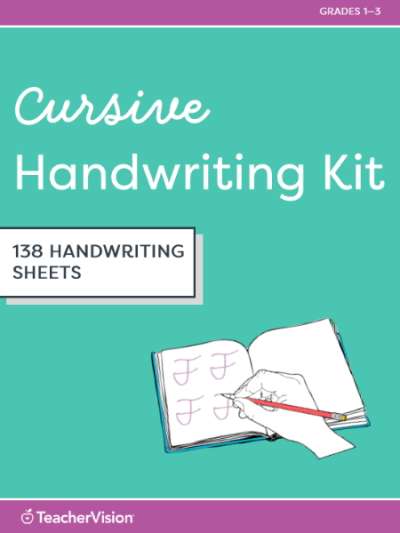
Related Resources

Persuasive Writing Examples and Prompts for Kids

Is your student stepping into the world of persuasive writing?
As a parent, it’s fun to watch your child learn the art of forming and supporting an argument.
(Plus, it’s a significant step toward critical thinking.)
If they need extra help, here are a few persuasive writing examples for kids along with 20 writing prompts to make it fun!
Why Persuasive Writing Is Important for Elementary Writers
Teaching persuasive writing is important because it’s a fundamental step in helping your child think critically.
By arguing a topic, your student will need to examine both sides, which is an essential component of critical thinking. Persuasive writing also inspires formation of opinion and sharing that opinion effectively.
Students as young as elementary-school age can learn to write persuasively. In fact, we’ll share some quick examples of persuasive essays for kids below.
First, let’s discuss the structure of a “mini” persuasive essay.
(If you have an older student, read our step-by-step guide to writing a persuasive essay .)
A Simplified Structure for Persuasive Writing
Of course, expectations and writing guidelines become more involved for older students, but elementary-aged students should keep it simple.
The basic features of persuasive writing can be broken down into 5 steps:
- Topic sentence
- Opening argument 1
- Concluding statement
A topic sentence introduces the argument and clearly expresses the writer’s viewpoint. For a younger child, this is simply a straightforward statement that clearly expresses “this is my opinion.”
The next three steps list “pros” that support their topic statement. Each argument should be distinctly stated.
Again, for an elementary-aged student, arguments can be brief and can simply be a list of reasons.
The concluding statement wraps up by summarizing the arguments and restating the opinion.
If this method of persuasive writing sounds complicated at first, rest assured, it’s not.
Let’s look at how you can easily reinforce this structure for your students, along with some examples.
Homeschool Mom Tip: Use a “Persuasive Text Structure” Poster
One effective method of teaching and reinforcing the persuasive writing model is by using a “persuasive structure” chart or poster.
A visual representation of the steps involved in persuasive writing is important for a few reasons:
- Some students learn best visually. It helps them understand and remember the method when they see it laid out in front of them.
- Graphic illustrations of the different components allow students to take in one piece at a time and avoid overwhelm.
- Hanging the poster where your children do their schoolwork makes it easy for them to reference the structure while they’re writing.
- Knowing the poster is nearby in case they get stuck helps make writing a calmer process.
One other tip I recommend is breaking up essay-style writing with creative writing assignments. ( Try these one-sentence writing prompts! ).
Kid-Friendly Persuasive Writing Examples
Along with tools like a poster, providing simple examples of persuasive writing is another helpful way to teach this new concept.
Here are a few examples of elementary-level persuasive paragraph examples that will give both you and your student an idea of what to expect.
Example 1: A Persuasive Argument About Cats
Cats are the best pets. They can be left alone all day without getting mad. Cats don’t bark, so they are not noisy like dogs. You don’t have to let cats go outside to use the bathroom. As you can see, cats are less work and easier to take care of than dogs.
Example 2: A Persuasive Argument About Meal Choices
French fries should be served with every meal. First, French fries are delicious. Second, French fries are made of potatoes, which are vegetables, and they can air-fried without oil. Also, French fries don’t cost a lot of money. Because they are tasty, cheap, and can be cooked in a healthy way, French fries a perfect side dish to every meal.
Example 3: A Persuasive Argument Against Littering
You should never litter because it is wrong. Littering pollutes the Earth. Littering is throwing trash around outside, which looks ugly. Littering can also make you sick if it has germs on it. Littering is wrong because it makes the world a dirty, unsanitary place to live.
20 Persuasive Writing Prompts for Kids
When you provide a step-by-step structure and supply examples of what is expected, you set your student up for writing success.
The final step in teaching persuasive writing to kids effectively is to present them with an antidote to the dreaded blank page.
To assist you with that, we’ve come up with 20 persuasive writing topics for your students to make it easier for them to get them started on their persuasive essays.
If they can’t come up with their own topics, one of these prompts should spark their interest.
These ideas for persuasive essays cover a wide variety of topics, so there should be something for everyone.
Plus, since persuasive writing is closely related to debate, you can also use these prompts as persuasive debate topics for kids :
- I deserve to be paid for my chores.
- Hamsters are the best type of pet.
- Everyone should eat a salad daily.
- Board games help you learn.
- Kids need free time to relax and play.
- You should always obey speed limits.
- Every family should have a dog.
- Dinner should always end with dessert.
- Homeschool students should get “snow days” as well.
- Kids should choose where the family spends summer vacation.
- I am old enough for a later bedtime.
- All students should learn a second language.
- School should only be 4 days per week.
- Soda is bad for you.
- I am responsible enough to learn how to cook.
- My cat should be allowed to sleep on my bed.
- Kids should be allowed to vote in their local elections at age 16.
- I am old enough to babysit and be paid.
- You should always wear a seatbelt in the car.
- Pizza is a healthy food.
I hope these persuasive texts and prompts for kids are helpful to you!
If you haven’t already, don’t forget to provide a few persuasive paragraph examples for your students to gain inspiration (and eliminate overwhelm).
If your student is entering 6th grade or above , we have a complete course that teaches students to write skillfully, think critically, and speak clearly as they explore the history of ideas! As a bonus in these dark days, Philosophy Adventure also teaches students to discern truth from error:

will your children recognize truth?
About the author.
Jordan Mitchell
How to Write a Persuasive Essay: Step-by-Step Guide + Examples
Have you ever tried to get somebody round to your way of thinking? Then you should know how daunting the task is. Still, if your persuasion is successful, the result is emotionally rewarding.
Our specialists will write a custom essay specially for you!
A persuasive essay is a type of writing that uses facts and logic to argument and substantiate such or another point of view. The purpose is to assure the reader that the author’s position is viable. In this article by Custom-writing experts, you can find a guide on persuasive writing, compelling examples, and outline structure. Continue reading and learn how to write a persuasive essay!
⚖️ Argumentative vs. Persuasive Essay
- 🐾 Step-by-Step Writing Guide
🔗 References
An argumentative essay intends to attack the opposing point of view, discussing its drawbacks and inconsistencies. A persuasive essay describes only the writer’s opinion, explaining why it is a believable one. In other words, you are not an opponent; you are an advocate.

A persuasive essay primarily resorts to emotions and personal ideas on a deeper level of meaning, while an argumentative one invokes logic reasoning. Despite the superficial similarity of these two genres, argumentative speech presupposes intense research of the subject, while persuasive speech requires a good knowledge of the audience.
🐾 How to Write a Persuasive Essay Step by Step
These nine steps are the closest thing you will find to a shortcut for writing to persuade. With practice, you may get through these steps quickly—or even figure out new techniques in persuasive writing.
📑 Persuasive Essay Outline
Below you’ll find an example of a persuasive essay outline . Remember: papers in this genre are more flexible than argumentative essays are. You don’t need to build a perfectly logical structure here. Your goal is to persuade your reader.
Just in 1 hour! We will write you a plagiarism-free paper in hardly more than 1 hour
Note that the next section contains a sample written in accordance with this outline.
Persuasive Essay Introduction
- Hook: start with an intriguing sentence.
- Background: describe the context of the discussed issue and familiarize the reader with the argument.
- Definitions: if your essay dwells upon a theoretical subject matter, be sure to explain the complicated terms.
- Thesis statement: state the purpose of your piece of writing clearly and concisely. This is the most substantial sentence of the entire essay, so take your time formulating it.
Persuasive Essay Body
Use the following template for each paragraph.
- Topic sentence: linking each new idea to the thesis, it introduces a paragraph. Use only one separate argument for each section, stating it in the topic sentence.
- Evidence: substantiate the previous sentence with reliable information. If it is your personal opinion, give the reasons why you think so.
- Analysis: build the argument, explaining how the evidence supports your thesis.
Persuasive Essay Conclusion
- Summary: briefly list the main points of the essay in a couple of sentences.
- Significance: connect your essay to a broader idea.
- Future: how can your argument be developed?
⭐ Persuasive Essay Examples
In this section, there are three great persuasive essay examples. The first one is written in accordance with the outline above, will the components indicated. Two others are downloadable.
Example #1: Being a Millionaire is a Bad Thing
Introduction, paragraph #1, paragraph #2, paragraph #3, example #2: teachers or doctors.
The importance of doctors in the period of the COVID-19 pandemic is difficult to overstate. The well-being of the nation depends on how well doctors can fulfill their duties before society. The US society acknowledges the importance of doctors and healthcare, as it is ready to pay large sums of money to cure the diseases. However, during the lockdown, students and parents all around the world began to understand the importance of teachers.
Before lockdown, everyone took the presence of teachers for granted, as they were always available free of charge. In this country, it has always been the case that while doctors received praises and monetary benefits, teachers remained humble, even though they play the most important role for humanity: passing the knowledge through generations. How fair is that? The present paper claims that even in the period of the pandemic, teachers contribute more to modern society than doctors do.
Example #3: Is Online or Homeschool More Effective?
The learning process can be divided into traditional education in an educational institution and distance learning. The latter form has recently become widely popular due to the development of technology. Besides, the COVID-19 pandemic is driving the increased interest in distance learning. However, there is controversy about whether this form of training is sufficient enough. This essay aims to examine online and homeschooling in a historical and contemporary context and to confirm the thesis that such activity is at least equivalent to a standard type of education.
Persuasive Essay Topics
- Why do managers hate the performance evaluation?
- Why human cloning should be prohibited.
- Social media have negative physical and psychological effect on teenagers.
- Using cell phones while driving should be completely forbidden.
- Why is business ethics important?
- Media should change its negative representation of ageing and older people.
- What is going on with the world?
- Good communication skills are critical for successful business.
- Why capitalism is the best economic system.
- Sleep is extremely important for human health and wellbeing.
- Face-to-face education is more effective than online education.
- Why video games can be beneficial for teenagers.
- Bullies should be expelled from school as they encroach on the school safety.
- Why accountancy is a great occupation and more people should consider it as a future career.
- The reasons art and music therapy should be included in basic health insurance.
- Impact of climate change on the indoor environment.
- Parents should vaccinate their children to prevent the spread of deadly diseases.
- Why celebrities should pay more attention to the values they promote.
- What is wrong with realism?
- Why water recycling should be every government’s priority.
- Media spreads fear and panic among people.
- Why e-business is very important for modern organizations.
- People should own guns for self-protection.
- The neccessity of container deposit legislation.
- We must save crocodiles to protect ecological balance.
- Why we should pay more attention to renewable energy projects.
- Anthropology is a critically relevant science.
- Why it’s important to create a new global financial order .
- Why biodiversity is crucial for the environment?
- Why process safety management is crucial for every organization.
- Speed limits must not be increased.
- What’s wrong with grades at school ?
- Why tattoos should be considered as a form of fine art.
- Using all-natural bath and body products is the best choice for human health and safety.
- What is cancel culture?
- Why the Internet has become a problem of modern society.
- Illegal immigrants should be provided with basic social services.
- Smoking in public places must be banned for people’s safety and comfort.
- Why it is essential to control our nutrition .
- How to stimulate economic growth?
- Why exercise is beneficial for people.
- Studying history is decisive for the modern world.
- We must decrease fuel consumption to stop global warming.
- Why fighting social inequality is necessary.
- Why should businesses welcome remote work?
- Social media harms communication within families.
- College athletes should be paid for their achievements.
- Electronic books should replace print books.
- People should stop cutting down rainforest .
- Why every company should have a web page .
- Tips To Write An Effective Persuasive Essay: The College Puzzle, Stanford University
- 31 Powerful Persuasive Writing Techniques: Writtent
- Persuasive Essay Outline: Houston Community College System
- Essays that Worked: Hamilton College
- Argumentative Essays // Purdue Writing Lab
- Persuasion – Writing for Success (University of Minnesota)
- Persuasive Writing (Manitoba Education)
- Share to Facebook
- Share to Twitter
- Share to LinkedIn
- Share to email
![how to write a persuasive essay 2nd grade Common Essay Mistakes—Writing Errors to Avoid [Updated]](https://custom-writing.org/blog/wp-content/uploads/2020/12/avoid-mistakes-ccw-284x153.jpg)
One of the most critical skills that students gain during their college years is assignment writing. Composing impressive essays and research papers can be quite challenging, especially for ESL students. Nonetheless, before learning the art of academic writing, you may make numerous common essay mistakes. Such involuntary errors appear in:...

You’re probably thinking: I’m no Mahatma Gandhi or Steve Jobs—what could I possibly write in my memoir? I don’t even know how to start an autobiography, let alone write the whole thing. But don’t worry: essay writing can be easy, and this autobiography example for students is here to show...
![how to write a persuasive essay 2nd grade Why I Want to Be a Teacher Essay: Writing Guide [2024]](https://custom-writing.org/blog/wp-content/uploads/2020/12/senior-male-professor-writing-blackboard-with-chalk3-284x153.jpg)
Some people know which profession to choose from childhood, while others decide much later in life. However, and whenever you come to it, you may have to elaborate on it in your personal statement or cover letter. This is widely known as “Why I Want to Be a Teacher” essay.
![how to write a persuasive essay 2nd grade Friendship Essay: Writing Guide & Topics on Friendship [New]](https://custom-writing.org/blog/wp-content/uploads/2020/12/smiley-female-friends-fist-bumping-284x153.jpg)
Assigned with an essay about friendship? Congrats! It’s one of the best tasks you could get. Digging through your memories and finding strong arguments for this paper can be an enjoyable experience. I bet you will cope with this task effortlessly as we can help you with the assignment. Just...

When you are assigned an autobiography to write, tens, and even hundreds of questions start buzzing in your head. How to write autobiography essay parts? What to include? How to make your autobiography writing flow? Don’t worry about all this and use the following three simple principles and 15 creative...

“Where is your thesis statement?” asks your teacher in a dramatic tone. “Where is my what?” you want to reply, but instead, you quickly point your finger at a random sentence in your paper, saying, “Here it is…” To avoid this sad situation (which is usually followed by a bad...

A life experience essay combines the elements of narration, description, and self-reflection. Such a paper has to focus on a single event that had a significant impact on a person’s worldview and values. Writing an essay about life experience prompts students to do the following: evaluate their behavior in specific...

Who has made a significant impact in your life and why? Essay on the topic might be challenging to write. One is usually asked to write such a text as a college admission essay. A topic for this paper can be of your choice or pre-established by the institution. Either...

Are you about to start writing a financial assistance essay? Most probably, you are applying for a scholarship that will provide additional funding for your education or that will help you meet some special research objectives.
![how to write a persuasive essay 2nd grade Growing Up Essay: Guide & Examples [2024]](https://custom-writing.org/blog/wp-content/uploads/2020/12/gardening-concept-with-mother-daughter-284x153.jpg)
What does it mean to grow up? Essays on this topic might be entertaining yet challenging to write. Growing up is usually associated with something new and exciting. It’s a period of everything new and unknown. Now, you’ve been assigned to write a growing up essay. You’re not a kid...
![how to write a persuasive essay 2nd grade Murder Essay: Examples, Topics, and Killer Tips [2024]](https://custom-writing.org/blog/wp-content/uploads/2020/12/man-holding-gun-as-evidence-284x153.jpeg)
Probably, a murder essay is not a fascinating assignment to complete. Talking about people’s deaths or crazy murderers can be depressing. However, all assignments are different, and you are supposed to work on every task hard. So, how are you going to deal with a murder essay? You can make...

Are you a nursing student? Then, you will definitely have an assignment to compose a nursing reflective essay. This task might be quite tough and challenging. But don’t stress out! Our professionals are willing to assist you.
Thank you for posting this!! I am trying to get notice to bring up a new language in our school because it doesn’t allow many languages so this really helped 🙂

I’m happy you found the article helpful, Allie. Thank you for your feedback!
Beautiful content
Thanks, Frances!
Useful article for blogging. I believe, for business, these blog tips will help me a lot.

Glad to know our tips are helpful for you! Hope you visit our blog again!
Tips for Writing an Effective Application Essay

How to Write an Effective Essay
Writing an essay for college admission gives you a chance to use your authentic voice and show your personality. It's an excellent opportunity to personalize your application beyond your academic credentials, and a well-written essay can have a positive influence come decision time.
Want to know how to draft an essay for your college application ? Here are some tips to keep in mind when writing.
Tips for Essay Writing
A typical college application essay, also known as a personal statement, is 400-600 words. Although that may seem short, writing about yourself can be challenging. It's not something you want to rush or put off at the last moment. Think of it as a critical piece of the application process. Follow these tips to write an impactful essay that can work in your favor.
1. Start Early.
Few people write well under pressure. Try to complete your first draft a few weeks before you have to turn it in. Many advisers recommend starting as early as the summer before your senior year in high school. That way, you have ample time to think about the prompt and craft the best personal statement possible.
You don't have to work on your essay every day, but you'll want to give yourself time to revise and edit. You may discover that you want to change your topic or think of a better way to frame it. Either way, the sooner you start, the better.
2. Understand the Prompt and Instructions.
Before you begin the writing process, take time to understand what the college wants from you. The worst thing you can do is skim through the instructions and submit a piece that doesn't even fit the bare minimum requirements or address the essay topic. Look at the prompt, consider the required word count, and note any unique details each school wants.
3. Create a Strong Opener.
Students seeking help for their application essays often have trouble getting things started. It's a challenging writing process. Finding the right words to start can be the hardest part.
Spending more time working on your opener is always a good idea. The opening sentence sets the stage for the rest of your piece. The introductory paragraph is what piques the interest of the reader, and it can immediately set your essay apart from the others.
4. Stay on Topic.
One of the most important things to remember is to keep to the essay topic. If you're applying to 10 or more colleges, it's easy to veer off course with so many application essays.
A common mistake many students make is trying to fit previously written essays into the mold of another college's requirements. This seems like a time-saving way to avoid writing new pieces entirely, but it often backfires. The result is usually a final piece that's generic, unfocused, or confusing. Always write a new essay for every application, no matter how long it takes.
5. Think About Your Response.
Don't try to guess what the admissions officials want to read. Your essay will be easier to write─and more exciting to read─if you’re genuinely enthusiastic about your subject. Here’s an example: If all your friends are writing application essays about covid-19, it may be a good idea to avoid that topic, unless during the pandemic you had a vivid, life-changing experience you're burning to share. Whatever topic you choose, avoid canned responses. Be creative.
6. Focus on You.
Essay prompts typically give you plenty of latitude, but panel members expect you to focus on a subject that is personal (although not overly intimate) and particular to you. Admissions counselors say the best essays help them learn something about the candidate that they would never know from reading the rest of the application.
7. Stay True to Your Voice.
Use your usual vocabulary. Avoid fancy language you wouldn't use in real life. Imagine yourself reading this essay aloud to a classroom full of people who have never met you. Keep a confident tone. Be wary of words and phrases that undercut that tone.
8. Be Specific and Factual.
Capitalize on real-life experiences. Your essay may give you the time and space to explain why a particular achievement meant so much to you. But resist the urge to exaggerate and embellish. Admissions counselors read thousands of essays each year. They can easily spot a fake.
9. Edit and Proofread.
When you finish the final draft, run it through the spell checker on your computer. Then don’t read your essay for a few days. You'll be more apt to spot typos and awkward grammar when you reread it. After that, ask a teacher, parent, or college student (preferably an English or communications major) to give it a quick read. While you're at it, double-check your word count.
Writing essays for college admission can be daunting, but it doesn't have to be. A well-crafted essay could be the deciding factor─in your favor. Keep these tips in mind, and you'll have no problem creating memorable pieces for every application.
What is the format of a college application essay?
Generally, essays for college admission follow a simple format that includes an opening paragraph, a lengthier body section, and a closing paragraph. You don't need to include a title, which will only take up extra space. Keep in mind that the exact format can vary from one college application to the next. Read the instructions and prompt for more guidance.
Most online applications will include a text box for your essay. If you're attaching it as a document, however, be sure to use a standard, 12-point font and use 1.5-spaced or double-spaced lines, unless the application specifies different font and spacing.
How do you start an essay?
The goal here is to use an attention grabber. Think of it as a way to reel the reader in and interest an admissions officer in what you have to say. There's no trick on how to start a college application essay. The best way you can approach this task is to flex your creative muscles and think outside the box.
You can start with openers such as relevant quotes, exciting anecdotes, or questions. Either way, the first sentence should be unique and intrigue the reader.
What should an essay include?
Every application essay you write should include details about yourself and past experiences. It's another opportunity to make yourself look like a fantastic applicant. Leverage your experiences. Tell a riveting story that fulfills the prompt.
What shouldn’t be included in an essay?
When writing a college application essay, it's usually best to avoid overly personal details and controversial topics. Although these topics might make for an intriguing essay, they can be tricky to express well. If you’re unsure if a topic is appropriate for your essay, check with your school counselor. An essay for college admission shouldn't include a list of achievements or academic accolades either. Your essay isn’t meant to be a rehashing of information the admissions panel can find elsewhere in your application.
How can you make your essay personal and interesting?
The best way to make your essay interesting is to write about something genuinely important to you. That could be an experience that changed your life or a valuable lesson that had an enormous impact on you. Whatever the case, speak from the heart, and be honest.
Is it OK to discuss mental health in an essay?
Mental health struggles can create challenges you must overcome during your education and could be an opportunity for you to show how you’ve handled challenges and overcome obstacles. If you’re considering writing your essay for college admission on this topic, consider talking to your school counselor or with an English teacher on how to frame the essay.
Related Articles

IMAGES
VIDEO
COMMENTS
A Persuasive Writing Unit Grade: 2 nd Grade Stage 1: Desired Results Understandings Students will understand that… • Writers have a purpose for writing • Writers choose topics that are important to them to write about • Writers can use words and ideas to influence others thoughts, actions, and feelings
Tip 2: Have your students Identify Persuasion in a Mentor Text. When using mentor texts, not only do I like to have students see persuasive writing in action, but I like to have them identify the persuasion in the texts. We do this using a think-aloud sheet like shown below.
3. Make a two-column chart for Session 1. Write Winter is the best season at the top of the chart. Write agree at the top of one column and disagree at the top of the other. 4. If you do not have classroom computers with Internet access, arrange to spend one session in your school's computer lab (see Session 3).
Thesis statement: Let the audience know your stance. After surveying the topic in the first part of the introduction, it is now time for the student writer to express their opinion and briefly preview the points they will make later in the essay. 2. Body Paragraphs.
By the time we're finished, most students understand how to gracefully and effectively add the conclusion sentence to finish the opinion essay. Just like we usually do, once we finish a section, we review that section carefully using handouts, sorts, color coding, games, and reviews. 8. Share an Opinion Essay Example.
Persuasive writing is a form of writing where the writer attempts to convince or persuade the audience to adopt a particular point of view or take a specific action through the development of logical arguments and a cohesive summary. Young children can be guided through a series of simple steps in an effort to develop their persuasive writing skills.
Help your second graders develop solid persuasive writing skills with these creative and engaging worksheets. Young writers are prompted to think deeply about topics, such as vacations, food, and field trips, and then practice forming an opinion and providing supporting evidence. These persuasive writing worksheets also support second graders ...
Students will write a persuasive essay convincing their teacher to provide a preferred snack to the class. This writing project will help your students write a persuasive essay using: ... Suggested Books for Persuasive Writing in 2nd Grade. When teaching a new topic, I love using resources that will provide my students with some background ...
Learn how to write a persuasive introduction!! Resources here!Differentiated for ages 6 to 12. Years/Grades 1-6. Includes Learning Intention, Success Criteri...
Browse Printable 2nd Grade Persuasive Essay Structure Worksheets. Award winning educational materials designed to help kids succeed. Start for free now! ... This handy worksheet breaks down opinion writing into easy-to-follow steps that will have your kids writing persuasive essays with ease in no time. 2nd grade. Reading & Writing. Worksheet ...
The Common Core State Standards Initiative suggests that second graders write short, simplified essays that include elements like introduction, body, conclusion, description and even argument. ... How to Teach Persuasive Writing to Fourth Grade . A Simple Way to Teach Third-Graders How to Write a... What Skills Must a Student Develop to Write ...
All Grades K-5 All Grades 6-12 PreK 6th Grade Kindergarten 7th Grade 1st Grade 8th Grade 2nd Grade 9th Grade 3rd Grade 10th Grade 4th Grade 11th Grade 5th ... The more we read, the better writers we become. Teaching students to write strong persuasive essays should always start with reading some top-notch models. This round-up of persuasive ...
Writing a second grade essay. In elementary school, children need to compose four kinds of passages: Long responses to questions (about five sentences or one paragraph), Essays (single paragraphs to five paragraphs). The other night I received a call from a father whose second-grade son needed to write an essay on his favorite animal.
Before your students use this tool independently, model its use for them. Choose a simple topic (such as, "Sixth Grade is the Best Grade" or "Why Our Lunch Period Should be Longer"). Then, fill in the Persuasion Map while discussing the process aloud, displaying the tool so that all students can see it. Review students' completed maps ...
Beyond that, there are a few more tricks that one can use to enhance one's skills quickly. These persuasive essay worksheets and activities will help students master these tricks. Creating Persuasive Attention Catchers Activity - Students practice creating persuasive leads that immediately push the reader toward their side of the argument.
Writing a Persuasive Letter (Gr. 2) Use this packet of writing printables to teach students how to write a persuasive letter. Model and blank graphic organizers are provided, as well as revision checklist. Students write the who, what, why, and how of their letter. This activity works well as part of your class lesson or as practice at home.
The basic features of persuasive writing can be broken down into 5 steps: Topic sentence. Opening argument 1. Argument 2. Argument 3. Concluding statement. A topic sentence introduces the argument and clearly expresses the writer's viewpoint.
Persuasive Writing Scoring Guide. Takes a clear position and supports it consistently with well-chosen reasons and/or examples; may use persuasive strategy to convey an argument. Takes a clear position and supports it with relevant reasons and/or examples through much of the essay. Takes a clear position and supports it with some relevant ...
Outline your argument. Outlining your entire essay before you get to writing it can help you organize your thoughts, research, and lay out your essay structure. Detail all your main points and pair them with all of the relevant, supporting evidence from your sources cited. 5. Write your introduction.
Take notes on the most convincing lines of support. And always cite your sources correctly. ️. Step 4: Focus on the Opinions against Your Position. If Step 3 didn't reveal flaws in your position, this step certainly will. Look for examples of persuasive essays that defend a point of view opposite to yours.
Here are some tips to keep in mind when writing. Tips for Essay Writing. A typical college application essay, also known as a personal statement, is 400-600 words. Although that may seem short, writing about yourself can be challenging. It's not something you want to rush or put off at the last moment.